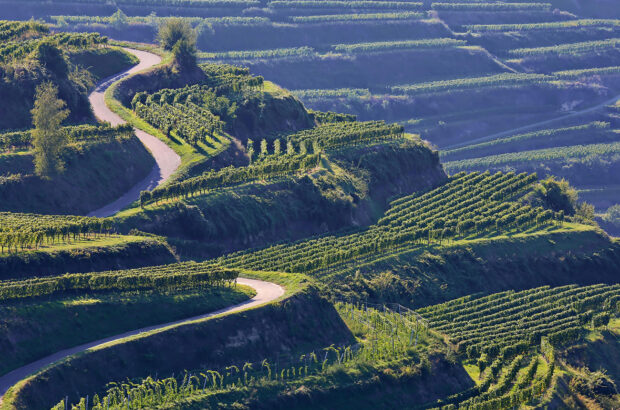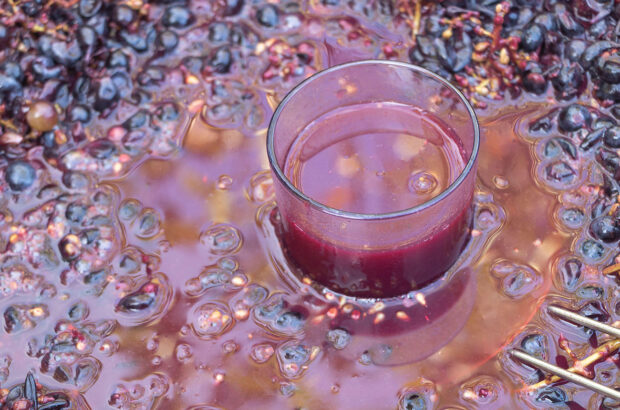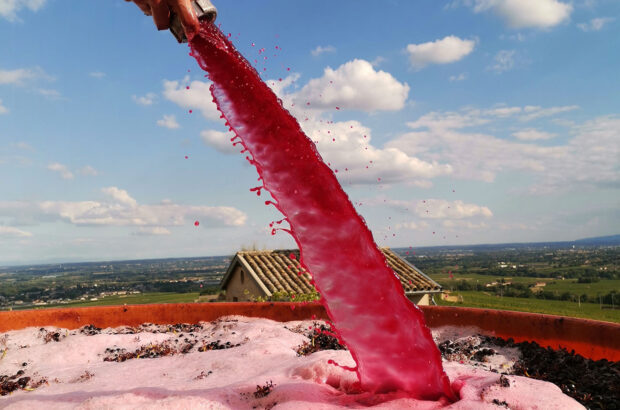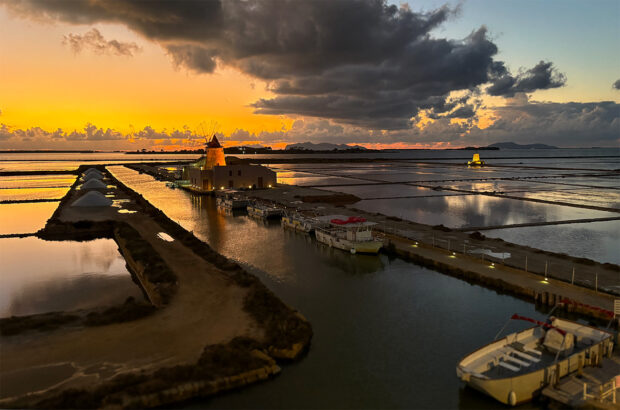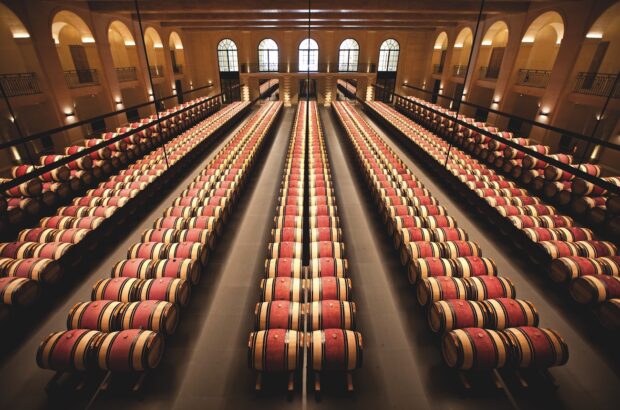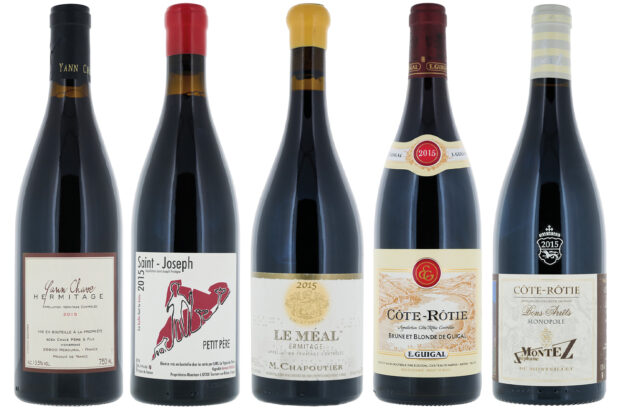Wine is a rarity – a splendid, value-added substance built upon an agricultural commodity. There is also, for the time being, far too much of it.
The 2024 growing season in California, my 17th vintage making wine, was gorgeous. Plentiful winter rain set the vines up for success. The summer then brought warm, dry days with cool nights – perfect for even ripening.
Relatively few heat spells and low disease pressure meant that there was no rush to pick. As the associate winemaker at Sonoma’s Brick and Mortar, I was working with pristine fruit brought in at its peak.
However, while cycling around Sonoma County months later, I saw row upon row of unharvested grapes. Fruit was left to rot on the vine in some of the state’s most prestigious appellations. For the 2024 harvest, there was no hiding in plain sight.
{"content":"PC9wPgo8cD48ZGl2IGNsYXNzPSJhZC1jb250YWluZXIgYWQtY29udGFpbmVyLS1tb2JpbGUiPjxkaXYgaWQ9InBvc3QtaW5saW5lLTIiIGNsYXNzPSJpcGMtYWR2ZXJ0Ij48L2Rpdj48L2Rpdj48L3A+CjxoMj5EZXNwZXJhdGUgdGltZXM8L2gyPgo8ZGl2IGlkPSJhdHRhY2htZW50XzU1NTYwMCIgc3R5bGU9IndpZHRoOiA2MTBweCIgY2xhc3M9IndwLWNhcHRpb24gYWxpZ25ub25lIj48aW1nIGZldGNocHJpb3JpdHk9ImhpZ2giIGRlY29kaW5nPSJhc3luYyIgYXJpYS1kZXNjcmliZWRieT0iY2FwdGlvbi1hdHRhY2htZW50LTU1NTYwMCIgY2xhc3M9Imxhenlsb2FkIGJsdXItdXAgc2l6ZS1mdWxsIHdwLWltYWdlLTU1NTYwMCIgZGF0YS1wcm9jZXNzZWQgc3JjPSJodHRwczovL3d3dy5kZWNhbnRlci5jb20ubWFzdGVyLnB1YmxpYy5rZXlzdG9uZS1wcm9kLWVrcy1ldXcxLmZ1dHVyZXBsYy5lbmdpbmVlcmluZy93cC1jb250ZW50L3RoZW1lcy9zaW1iYS10aGVtZS9hc3NldHMvaW1hZ2VzL3BsYWNlaG9sZGVyLnBuZyIgZGF0YS1zcmM9Imh0dHBzOi8va2V5YXNzZXRzLnRpbWVpbmN1ay5uZXQvaW5zcGlyZXdwL2xpdmUvd3AtY29udGVudC91cGxvYWRzL3NpdGVzLzM0LzIwMjUvMDQvQS1oZWxpY29wdGVyLWZpZ2h0cy1hLXdpbGRmaXJlLW5lYXItdmluZXlhcmRzLWluLU5hcGEtQ291bnR5LWluLTIwMjAuLUNyZWRpdC1QaGlsaXAtUGFjaGVjby1CbG9vbWJlcmctR2V0dHktSW1hZ2VzLmpwZyIgYWx0PSIiIHdpZHRoPSI2MDAiIGhlaWdodD0iNDAwIiBkYXRhLXNpemVzPSJhdXRvIiBkYXRhLXNyY3NldD0iaHR0cHM6Ly9rZXlhc3NldHMudGltZWluY3VrLm5ldC9pbnNwaXJld3AvbGl2ZS93cC1jb250ZW50L3VwbG9hZHMvc2l0ZXMvMzQvMjAyNS8wNC9BLWhlbGljb3B0ZXItZmlnaHRzLWEtd2lsZGZpcmUtbmVhci12aW5leWFyZHMtaW4tTmFwYS1Db3VudHktaW4tMjAyMC4tQ3JlZGl0LVBoaWxpcC1QYWNoZWNvLUJsb29tYmVyZy1HZXR0eS1JbWFnZXMuanBnIDYwMHcsIGh0dHBzOi8va2V5YXNzZXRzLnRpbWVpbmN1ay5uZXQvaW5zcGlyZXdwL2xpdmUvd3AtY29udGVudC91cGxvYWRzL3NpdGVzLzM0LzIwMjUvMDQvQS1oZWxpY29wdGVyLWZpZ2h0cy1hLXdpbGRmaXJlLW5lYXItdmluZXlhcmRzLWluLU5hcGEtQ291bnR5LWluLTIwMjAuLUNyZWRpdC1QaGlsaXAtUGFjaGVjby1CbG9vbWJlcmctR2V0dHktSW1hZ2VzLTMwMHgyMDAuanBnIDMwMHcsIGh0dHBzOi8va2V5YXNzZXRzLnRpbWVpbmN1ay5uZXQvaW5zcGlyZXdwL2xpdmUvd3AtY29udGVudC91cGxvYWRzL3NpdGVzLzM0LzIwMjUvMDQvQS1oZWxpY29wdGVyLWZpZ2h0cy1hLXdpbGRmaXJlLW5lYXItdmluZXlhcmRzLWluLU5hcGEtQ291bnR5LWluLTIwMjAuLUNyZWRpdC1QaGlsaXAtUGFjaGVjby1CbG9vbWJlcmctR2V0dHktSW1hZ2VzLTEzNXg5MC5qcGcgMTM1dywgaHR0cHM6Ly9rZXlhc3NldHMudGltZWluY3VrLm5ldC9pbnNwaXJld3AvbGl2ZS93cC1jb250ZW50L3VwbG9hZHMvc2l0ZXMvMzQvMjAyNS8wNC9BLWhlbGljb3B0ZXItZmlnaHRzLWEtd2lsZGZpcmUtbmVhci12aW5leWFyZHMtaW4tTmFwYS1Db3VudHktaW4tMjAyMC4tQ3JlZGl0LVBoaWxpcC1QYWNoZWNvLUJsb29tYmVyZy1HZXR0eS1JbWFnZXMtMzIweDIxMy5qcGcgMzIwdyIgc2l6ZXM9IihtYXgtd2lkdGg6IDYwMHB4KSAxMDB2dywgNjAwcHgiIC8+PHAgaWQ9ImNhcHRpb24tYXR0YWNobWVudC01NTU2MDAiIGNsYXNzPSJ3cC1jYXB0aW9uLXRleHQiPkEgaGVsaWNvcHRlciBmaWdodHMgYSB3aWxkZmlyZSBvdmVyIGEgdmluZXlhcmQgaW4gTmFwYSBDb3VudHksIENhbGlmb3JuaWEuIENyZWRpdDogUGhpbGlwIFBhY2hlY28vQmxvb21iZXJnL0dldHR5IEltYWdlczwvcD48L2Rpdj4KPHA+VGhlIGN1c3RvbSBjcnVzaCBmYWNpbGl0eSB0aGF0IEkgd29ya2VkIGZvciByZWNlaXZlZCBjYWxscyBmcm9tIGdyb3dlcnMgb24gYW4gYWxtb3N0IGRhaWx5IGJhc2lzLCBhc2tpbmcgdXMgdG8gdmluaWZ5IHRoZWlyIGZydWl0IGZvciB0aGVtIGFuZCBvZmZlcmluZyBhbGwgbWFubmVyIG9mIGRlYWxzLiDigJhUYWtlIGhhbGYgdGhlIGZydWl0IGZvciB5b3Vyc2VsdmVzLOKAmSB3YXMgb2Z0ZW4gdGhlIHBsZWEuPC9wPgo8cD5Qcm9taXNlcyB0byBwYXkgbWF5IGhhdmUgYmVlbiB3ZWxsIGludGVudGlvbmVkLCBidXQgdGhlcmUgYXJlIG5vIGd1YXJhbnRlZXMuIE1ham9yIHdpbmVyaWVzIGhhdmUgZ29uZSBiYW5rcnVwdC48L3A+CjxkaXYgY2xhc3M9ImFkLWNvbnRhaW5lciBhZC1jb250YWluZXItLW1vYmlsZSI+PGRpdiBpZD0icG9zdC1pbmxpbmUtMyIgY2xhc3M9ImlwYy1hZHZlcnQiPjwvZGl2PjwvZGl2Pgo8cD5UaGF0IHVuc3Bva2VuLWZvciB3aW5lIGluIHRoZSB0YW5rIGxvc2VzIHZhbHVlIGFzIHRoZSBkYXlzIGdvIGJ5LiBJdCB3aWxsIGV2ZW50dWFsbHkgYmUgcGlja2VkIHVwIGZvciBhIHNvbmcgYW5kIGJsZW5kZWQgaW50byBvbmUgZ2VuZXJpYyBidWxrIHdpbmUgb3IgYW5vdGhlciwgaXRzIGlkZW50aXR5IGFuZCBpbnRlZ3JpdHkgbG9zdCwgYW55IGludm9jYXRpb25zIHRvIHRlcnJvaXIgYSBob2xsb3cgam9rZS48L3A+CjxwPuKAmERvZXMgdGhpcyBub3QgbWVhbiBhbWF6aW5nIHByaWNlcyBhbmQgcGxlbnRpZnVsIHdpbmUgZm9yIGFsbD\/igJkgb25lIGNvdWxkIGJlIGZvcmdpdmVuIGZvciB3b25kZXJpbmcuIFNvcnQgb2YsIGluIHRoZSBzaG9ydC10ZXJtLCBpcyB0aGUgYW5zd2VyLjwvcD4KPGRpdiBjbGFzcz0iYWQtY29udGFpbmVyIGFkLWNvbnRhaW5lci0tbW9iaWxlIj48ZGl2IGlkPSJwb3N0LWlubGluZS00IiBjbGFzcz0iaXBjLWFkdmVydCI+PC9kaXY+PC9kaXY+CjxwPkhvd2V2ZXIsIG92ZXIgdGltZSwgaXQgYWxzbyBtZWFucyBhIGhpdCB0byBxdWFsaXR5LCB2aW5leWFyZHMgYW5kIHRoZSBlbnZpcm9ubWVudC48L3A+CjxwPlRoZSBDYWxpZm9ybmlhIHdpbmUgaW5kdXN0cnkgbXVzdCBmaWd1cmUgb3V0IHdoYXQgaXQgd2FudHMgdG8gYmUsIGFuZCB3ZSwgZmVsbG93IHdpbmUgbG92ZXJzLCBzaG91bGQgdW5kZXJzdGFuZCB0aGUgcm9sZSB0aGF0IHdlIHBsYXkgaW4gY3JhZnRpbmcgdGhlIGZ1dHVyZSBvZiB3aW5lLjwvcD4KPGRpdiBjbGFzcz0iYWQtY29udGFpbmVyIGFkLWNvbnRhaW5lci0tbW9iaWxlIj48ZGl2IGlkPSJwb3N0LWlubGluZS01IiBjbGFzcz0iaXBjLWFkdmVydCI+PC9kaXY+PC9kaXY+CjxwPkFzIEkgd3JpdGUgdGhpcywgdGhlcmUgYXJlIDM2MCBDYWxpZm9ybmlhIGJ1bGsgd2luZSBzYWxlIGxpc3RpbmdzIG9uIG9uZSBvbmxpbmUgbWFya2V0cGxhY2UgYWxvbmUsIG1hbnkgZGF0aW5nIGJhY2sgb3ZlciBtdWx0aXBsZSB2aW50YWdlcy4gSW4gb25lLCAxOCwwMDAgVVMgZ2FsbG9ucyAoYWJvdXQgNjgsMDAwTCkgb2YgMjAyNCBNZW5kb2Npbm8gQ2hhcmRvbm5heSBpcyBvcHRpbWlzdGljYWxseSBwcmljZWQgYXQgJDEyIHBlciBnYWxsb24gKCQzLjE3L0wg4oCTIGFib3V0IMKjMi41MCkuPC9wPgo8cD5Db21wZXRpdGlvbiBpcyBzdGlmZi4gVGVucyBvZiB0aG91c2FuZHMgb2YgZ2FsbG9ucyBhcmUgb24gb2ZmZXIgZm9yIGxlc3MuIENvbnNpZGVyIHRoZSAyMDIwIEFsZXhhbmRlciBWYWxsZXkgWmluZmFuZGVsLCBsaXN0ZWQgYXQgJDMgcGVyIGdhbGxvbi48L3A+CjxwPlRoaXMgaXMgYSBzdGFyayBpbmRpY2F0aW9uIG9mIGhvdyBwdW5pc2hpbmcgdGhlIHBhc3Npbmcgb2YgdGltZSBpcyB0byB0aGUgcGVyY2VpdmVkIHZhbHVlIG9mIHVuc29sZCB3aW5lLiBTbyBob3cgZGlkIHdlIGdldCBoZXJlPzwvcD4KPGgyPlRoZSBub3Rpb24gb2YgaW5maW5pdGUgZ3Jvd3RoPC9oMj4KPGRpdiBpZD0iYXR0YWNobWVudF81NTU1ODciIHN0eWxlPSJ3aWR0aDogNjEwcHgiIGNsYXNzPSJ3cC1jYXB0aW9uIGFsaWdubm9uZSI+PGltZyBkZWNvZGluZz0iYXN5bmMiIGFyaWEtZGVzY3JpYmVkYnk9ImNhcHRpb24tYXR0YWNobWVudC01NTU1ODciIGNsYXNzPSJsYXp5bG9hZCBibHVyLXVwIHNpemUtZnVsbCB3cC1pbWFnZS01NTU1ODciIGRhdGEtcHJvY2Vzc2VkIHNyYz0iaHR0cHM6Ly93d3cuZGVjYW50ZXIuY29tLm1hc3Rlci5wdWJsaWMua2V5c3RvbmUtcHJvZC1la3MtZXV3MS5mdXR1cmVwbGMuZW5naW5lZXJpbmcvd3AtY29udGVudC90aGVtZXMvc2ltYmEtdGhlbWUvYXNzZXRzL2ltYWdlcy9wbGFjZWhvbGRlci5wbmciIGRhdGEtc3JjPSJodHRwczovL2tleWFzc2V0cy50aW1laW5jdWsubmV0L2luc3BpcmV3cC9saXZlL3dwLWNvbnRlbnQvdXBsb2Fkcy9zaXRlcy8zNC8yMDI1LzA0L1lvdW5nLXBlb3BsZS1jaG9vc2luZy1tb2NrdGFpbHMtb3Zlci13aW5lLWhhcy1oZWxwZWQtdG8taW5jcmVhc2UtQ2FsaWZvcm5pYXMtZ3JhcGUtZ2x1dC4tQ3JlZGl0LVNyZGphbnBhdi1HZXR0eS1JbWFnZXMuanBnIiBhbHQ9IiIgd2lkdGg9IjYwMCIgaGVpZ2h0PSI0MDAiIGRhdGEtc2l6ZXM9ImF1dG8iIGRhdGEtc3Jjc2V0PSJodHRwczovL2tleWFzc2V0cy50aW1laW5jdWsubmV0L2luc3BpcmV3cC9saXZlL3dwLWNvbnRlbnQvdXBsb2Fkcy9zaXRlcy8zNC8yMDI1LzA0L1lvdW5nLXBlb3BsZS1jaG9vc2luZy1tb2NrdGFpbHMtb3Zlci13aW5lLWhhcy1oZWxwZWQtdG8taW5jcmVhc2UtQ2FsaWZvcm5pYXMtZ3JhcGUtZ2x1dC4tQ3JlZGl0LVNyZGphbnBhdi1HZXR0eS1JbWFnZXMuanBnIDYwMHcsIGh0dHBzOi8va2V5YXNzZXRzLnRpbWVpbmN1ay5uZXQvaW5zcGlyZXdwL2xpdmUvd3AtY29udGVudC91cGxvYWRzL3NpdGVzLzM0LzIwMjUvMDQvWW91bmctcGVvcGxlLWNob29zaW5nLW1vY2t0YWlscy1vdmVyLXdpbmUtaGFzLWhlbHBlZC10by1pbmNyZWFzZS1DYWxpZm9ybmlhcy1ncmFwZS1nbHV0Li1DcmVkaXQtU3JkamFucGF2LUdldHR5LUltYWdlcy0zMDB4MjAwLmpwZyAzMDB3LCBodHRwczovL2tleWFzc2V0cy50aW1laW5jdWsubmV0L2luc3BpcmV3cC9saXZlL3dwLWNvbnRlbnQvdXBsb2Fkcy9zaXRlcy8zNC8yMDI1LzA0L1lvdW5nLXBlb3BsZS1jaG9vc2luZy1tb2NrdGFpbHMtb3Zlci13aW5lLWhhcy1oZWxwZWQtdG8taW5jcmVhc2UtQ2FsaWZvcm5pYXMtZ3JhcGUtZ2x1dC4tQ3JlZGl0LVNyZGphbnBhdi1HZXR0eS1JbWFnZXMtMTM1eDkwLmpwZyAxMzV3LCBodHRwczovL2tleWFzc2V0cy50aW1laW5jdWsubmV0L2luc3BpcmV3cC9saXZlL3dwLWNvbnRlbnQvdXBsb2Fkcy9zaXRlcy8zNC8yMDI1LzA0L1lvdW5nLXBlb3BsZS1jaG9vc2luZy1tb2NrdGFpbHMtb3Zlci13aW5lLWhhcy1oZWxwZWQtdG8taW5jcmVhc2UtQ2FsaWZvcm5pYXMtZ3JhcGUtZ2x1dC4tQ3JlZGl0LVNyZGphbnBhdi1HZXR0eS1JbWFnZXMtMzIweDIxMy5qcGcgMzIwdyIgc2l6ZXM9IihtYXgtd2lkdGg6IDYwMHB4KSAxMDB2dywgNjAwcHgiIC8+PHAgaWQ9ImNhcHRpb24tYXR0YWNobWVudC01NTU1ODciIGNsYXNzPSJ3cC1jYXB0aW9uLXRleHQiPllvdW5nIHBlb3BsZSBjaG9vc2luZyBtb2NrdGFpbHMgb3ZlciB3aW5lIGhhcyBoZWxwZWQgdG8gaW5jcmVhc2UgQ2FsaWZvcm5pYeKAmXMgZ3JhcGUgZ2x1dC4gQ3JlZGl0OiBTcmRqYW5wYXYvR2V0dHkgSW1hZ2VzPC9wPjwvZGl2Pgo8cD5UaGUgbGFzdCB0d28tcGx1cyBkZWNhZGVzIHNhdyBlbm9ybW91cyBvdmVyLXBsYW50aW5nIG9mIG5ldyB2aW5leWFyZHMsIHNwdXJyZWQgb24gYnkgZXhjZXNzaXZlbHkgZXh1YmVyYW50IHByb2plY3Rpb25zIGJhc2VkIG9uIHBhc3QgZ3Jvd3RoLjwvcD4KPHA+SW4gdGhlIDE5OTBzIGFuZCAyMDAwcywgQW1lcmljYW5zIHdlcmUgcmFwaWRseSBiZWNvbWluZyB3aW5lIGRyaW5rZXJzOyB0aGUgbWlzdGFrZSBsYXkgaW4gdGhpbmtpbmcgdGhhdCB0aGlzIHRyZW5kIHdvdWxkIGNvbnRpbnVlIHVudGlsIHdpbmUgc2F0IG9uIGV2ZXJ5IHRhYmxlLjwvcD4KPHA+QWRkIHRvIHRoaXMgdGhlIHN3aXJsIG9mIGNvbXBsZXggZmFjdG9ycyBzdXJyb3VuZGluZyBkcmlua3MgY3VsdHVyZSDigJMgdGhlIHNvYmVyLWN1cmlvdXMgbW92ZW1lbnQsIGFkYXB0b2dlbmljIGJldmVyYWdlcyAoaW52b2x2aW5nIGFjdGl2ZSBpbmdyZWRpZW50cyksIGNvY2t0YWlscywgTWlsbGVubmlhbHMgbm90IHdhbnRpbmcgdG8gYmUgbGlrZSB0aGVpciBwYXJlbnRzLCBhbmQgY29uc3VtZXIgY29uZmlkZW5jZSDigJMgYW5kIHBsb3AhIFdl4oCZdmUgbGFuZGVkIGluIHRoaXMgd2luZS1kYXJrIHNlYS48L3A+CjxwPkZvciBmaXZlIHllYXJzIG9yIG1vcmUsIENhbGlmb3JuaWFuIG1hcmtldGluZyBjb29wZXJhdGl2ZXMgc3VjaCBhcyBBbGxpZWQgR3JhcGUgR3Jvd2VycyBoYXZlIGlzc3VlZCB3YXJuaW5ncyBhYm91dCB0aGUgb3Zlci1wbGFudGluZyBvZiBuZXcgdmluZXlhcmRzIGFuZCBoYXZlIGJlZW4gdXJnaW5nIGZhcm1lcnMgdG8gcmlwIHZpbmVzIG91dC4gSXQgdGFrZXMgeWVhcnMgYmVmb3JlIG5ldyBhY3JlcyBtYWtlIHRoZW1zZWx2ZXMgZmVsdC48L3A+CjxwPkZydWl0IGNvbWVzIG9ubGluZSAocmVhZHkgZm9yIGNvbW1lcmNpYWwgd2luZSBwcm9kdWN0aW9uKSBpbiB5ZWFyIHRocmVlLCBvciByZWFsbHkgeWVhciBmb3VyLiBJZiBvbmUgaXNu4oCZdCBwYXlpbmcgYXR0ZW50aW9uIHRvIHdobyBpcyBwbGFudGluZyB3aGF0LCBvbmUgY2FuIHF1aWNrbHkgYmVjb21lIHBhcnQgb2YgdGhlIGV4Y2Vzcy48L3A+CjxwPlRoZSBsb3cteWllbGRpbmcgZHJvdWdodCB5ZWFycyBvZiAyMDE0LTIwMTYgZ2F2ZSBwcm9kdWNlcnMgYSBmYWxzZSBzZW5zZSBvZiBzY2FyY2l0eSwgd2hpY2ggZnVlbGxlZCB0aGUgZ3Jvd2Vyc+KAmSByZWZ1c2FsIHRvIGhlZWQgdGhlIHdhcm5pbmdzIG9mIG92ZXJzdXBwbHkuIFRoZW4gTW90aGVyIE5hdHVyZSBsYXllcmVkIG9uIGV4dHJhIGNvbXBsZXhpdHkuPC9wPgo8aDI+TWFza2luZyB0aGUgcHJvYmxlbTwvaDI+CjxwPldpbGRmaXJlcyBpbiAyMDE3LCAyMDE5IGFuZCBldmVuIG1vcmUgc28gaW4gMjAyMCBzbGFzaGVkIHByb2R1Y3Rpb24gYWNyb3NzIHRoZSBzdGF0ZSwgbW9zdCBub3RhYmx5IGluIDxzdHJvbmc+PGEgaHJlZj0iaHR0cHM6Ly93d3cuZGVjYW50ZXIuY29tLm1hc3Rlci5wdWJsaWMua2V5c3RvbmUtcHJvZC1la3MtZXV3MS5mdXR1cmVwbGMuZW5naW5lZXJpbmcubWFzdGVyLnB1YmxpYy5rZXlzdG9uZS1wcm9kLWVrcy1ldXcxLmZ1dHVyZXBsYy5lbmdpbmVlcmluZy93aW5lL3dpbmUtcmVnaW9ucy9uYXBhLXZhbGxleS8iIHRhcmdldD0iX2JsYW5rIiByZWw9Im5vb3BlbmVyIj5OYXBhPC9hPjwvc3Ryb25nPiwgU29ub21hIGFuZCA8c3Ryb25nPjxhIGhyZWY9Imh0dHBzOi8vd3d3LmRlY2FudGVyLmNvbS5tYXN0ZXIucHVibGljLmtleXN0b25lLXByb2QtZWtzLWV1dzEuZnV0dXJlcGxjLmVuZ2luZWVyaW5nLm1hc3Rlci5wdWJsaWMua2V5c3RvbmUtcHJvZC1la3MtZXV3MS5mdXR1cmVwbGMuZW5naW5lZXJpbmcvd2luZS10cmF2ZWwvbWVuZG9jaW5vLXRyYXZlbC1ndWlkZS00NzkxMjEvIiB0YXJnZXQ9Il9ibGFuayIgcmVsPSJub29wZW5lciI+TWVuZG9jaW5vPC9hPiA8L3N0cm9uZz5jb3VudGllcy4gU21va2UgcmVuZGVyZWQgdGhvdXNhbmRzIG9mIHRvbm5lcyBvZiBmcnVpdCB1bnNhbHZhZ2VhYmxlLjwvcD4KPHA+VW5zY3J1cHVsb3VzIHByb2R1Y2VycyBhbHJlYWR5IHNpdHRpbmcgb24gbW9yZSB3aW5lIHRoYW4gdGhleSBjb3VsZCBzZWxsIHVzZWQgdGhlIGZpcmVzIGFzIGFuIGV4Y3VzZSBub3QgdG8gYWNjZXB0IHBlcmZlY3RseSBnb29kIGNvbnRyYWN0ZWQgZnJ1aXQuIEhlcmUgd2FzIHRoZWlyIG91dC4gVGhlIGVuc3Vpbmcgc2NhcmNpdHkgbWFza2VkIHRoZSBwcm9ibGVtIHlldCBhZ2Fpbi48L3A+CjxwPlRoZW4gY2FtZSBDb3ZpZCwgYnJpbmdpbmcgd2l0aCBpdCBhIHRlbXBvcmFyeSB1cHRpY2sgaW4gd2luZSBkcmlua2luZyB0aGF0IGdhdmUgd2luZXJpZXMgYSBtaXNndWlkZWQgc2Vuc2Ugb2YgZXh1YmVyYW5jZSDigJMgd2luZSBpcyBiYWNrISBXaW5lIGNsdWIgbWVtYmVyc2hpcHMgYXJlIHVwISBXZeKAmXJlIHNhdmVkISBOb3Qgc28uIFdoYXQgaGFwcGVucyB0byBhbGwgb2YgdGhlIGV4dHJhIGZydWl0PzwvcD4KPHA+Q3VlIHRoZSByaXNlIG9mIOKAmHByaXZhdGUgbGFiZWzigJkgd2luZSBjb21wYW5pZXMgdGhhdCBjb250cmFjdCB0byBtYWtlIGEg4oCYQ3V2w6llIENvc3RDdXTigJkgb3IgYSDigJhCb2LigJlzIDgwdGjigJkgYmlydGhkYXkgd2luZS4gQ3VlIHRoZSBtYXNzLW1hcmtldGVkIGJveGVkIHdpbmVzLjwvcD4KPHA+VW5kZXJzdGFuZCB0aGF0IHRoZXNlIGFyZSwgYnkgYW5kIGxhcmdlLCBwdXQgb3V0IGJ5IG9wcG9ydHVuaXN0aWMgZW50cmVwcmVuZXVycy9tYXJrZXRlcnMg4oCTIG5vdCBhY3R1YWwgd2luZW1ha2VycyDigJMgcGlja2luZyB1cCB3aW5lIHRoYXQgc29tZW9uZSBlbHNlIGlzIGZyZXF1ZW50bHkgc2VsbGluZyBhdCBhIGxvc3MuPC9wPgo8cD5UaGluayBtYXJrZXQgZm9yY2VzLCB0aGluayBnbG9iYWwgbWFya2V0cy48L3A+CjxoMj5CdXlpbmcgaW4gYnVsazwvaDI+CjxkaXYgaWQ9ImF0dGFjaG1lbnRfNTU1NTg5IiBzdHlsZT0id2lkdGg6IDYxMHB4IiBjbGFzcz0id3AtY2FwdGlvbiBhbGlnbm5vbmUiPjxpbWcgZGVjb2Rpbmc9ImFzeW5jIiBhcmlhLWRlc2NyaWJlZGJ5PSJjYXB0aW9uLWF0dGFjaG1lbnQtNTU1NTg5IiBjbGFzcz0ibGF6eWxvYWQgYmx1ci11cCBzaXplLWZ1bGwgd3AtaW1hZ2UtNTU1NTg5IiBkYXRhLXByb2Nlc3NlZCBzcmM9Imh0dHBzOi8vd3d3LmRlY2FudGVyLmNvbS5tYXN0ZXIucHVibGljLmtleXN0b25lLXByb2QtZWtzLWV1dzEuZnV0dXJlcGxjLmVuZ2luZWVyaW5nL3dwLWNvbnRlbnQvdGhlbWVzL3NpbWJhLXRoZW1lL2Fzc2V0cy9pbWFnZXMvcGxhY2Vob2xkZXIucG5nIiBkYXRhLXNyYz0iaHR0cHM6Ly9rZXlhc3NldHMudGltZWluY3VrLm5ldC9pbnNwaXJld3AvbGl2ZS93cC1jb250ZW50L3VwbG9hZHMvc2l0ZXMvMzQvMjAyNS8wNC9XaW5lLWV4cG9ydHMtb2Z0ZW4tdHJhdmVsLWluLWJ1bGstZmx1aWQtc2hpcHBpbmctY29udGFpbmVycy4tQ3JlZGl0LUJyaWFuLUJyb3duLUdldHR5LUltYWdlcy5qcGciIGFsdD0iIiB3aWR0aD0iNjAwIiBoZWlnaHQ9IjQwMCIgZGF0YS1zaXplcz0iYXV0byIgZGF0YS1zcmNzZXQ9Imh0dHBzOi8va2V5YXNzZXRzLnRpbWVpbmN1ay5uZXQvaW5zcGlyZXdwL2xpdmUvd3AtY29udGVudC91cGxvYWRzL3NpdGVzLzM0LzIwMjUvMDQvV2luZS1leHBvcnRzLW9mdGVuLXRyYXZlbC1pbi1idWxrLWZsdWlkLXNoaXBwaW5nLWNvbnRhaW5lcnMuLUNyZWRpdC1Ccmlhbi1Ccm93bi1HZXR0eS1JbWFnZXMuanBnIDYwMHcsIGh0dHBzOi8va2V5YXNzZXRzLnRpbWVpbmN1ay5uZXQvaW5zcGlyZXdwL2xpdmUvd3AtY29udGVudC91cGxvYWRzL3NpdGVzLzM0LzIwMjUvMDQvV2luZS1leHBvcnRzLW9mdGVuLXRyYXZlbC1pbi1idWxrLWZsdWlkLXNoaXBwaW5nLWNvbnRhaW5lcnMuLUNyZWRpdC1Ccmlhbi1Ccm93bi1HZXR0eS1JbWFnZXMtMzAweDIwMC5qcGcgMzAwdywgaHR0cHM6Ly9rZXlhc3NldHMudGltZWluY3VrLm5ldC9pbnNwaXJld3AvbGl2ZS93cC1jb250ZW50L3VwbG9hZHMvc2l0ZXMvMzQvMjAyNS8wNC9XaW5lLWV4cG9ydHMtb2Z0ZW4tdHJhdmVsLWluLWJ1bGstZmx1aWQtc2hpcHBpbmctY29udGFpbmVycy4tQ3JlZGl0LUJyaWFuLUJyb3duLUdldHR5LUltYWdlcy0xMzV4OTAuanBnIDEzNXcsIGh0dHBzOi8va2V5YXNzZXRzLnRpbWVpbmN1ay5uZXQvaW5zcGlyZXdwL2xpdmUvd3AtY29udGVudC91cGxvYWRzL3NpdGVzLzM0LzIwMjUvMDQvV2luZS1leHBvcnRzLW9mdGVuLXRyYXZlbC1pbi1idWxrLWZsdWlkLXNoaXBwaW5nLWNvbnRhaW5lcnMuLUNyZWRpdC1Ccmlhbi1Ccm93bi1HZXR0eS1JbWFnZXMtMzIweDIxMy5qcGcgMzIwdyIgc2l6ZXM9IihtYXgtd2lkdGg6IDYwMHB4KSAxMDB2dywgNjAwcHgiIC8+PHAgaWQ9ImNhcHRpb24tYXR0YWNobWVudC01NTU1ODkiIGNsYXNzPSJ3cC1jYXB0aW9uLXRleHQiPldpbmUgZXhwb3J0cyBvZnRlbiB0cmF2ZWwgaW4gYnVsay1mbHVpZCBzaGlwcGluZyBjb250YWluZXJzLiBDcmVkaXQ6IEJyaWFuIEJyb3duL0dldHR5IEltYWdlczwvcD48L2Rpdj4KPHA+UGljdHVyZSBlbm9ybW91cyBwbGFzdGljIHRhbmtzIGZ1bGwgb2Ygd2luZSwgc2xvc2hpbmcgYXMgdGhleSByaWRlIG9uIG1lcmNoYW50IG1hcmluZSBzaGlwcyBhY3Jvc3MgdGhlIGdsb2JlLCBmcm9tIEF1c3RyYWxpYSB0byB0aGUgVUssIENoaWxlIHRvIENhbmFkYSwgU2FuIEZyYW5jaXNjbyB0aHJvdWdoIHRoZSBQYW5hbWEgQ2FuYWwgYW5kIG9uIHRv4oCmPzwvcD4KPHA+VGhpcyBpc27igJl0IGEgZHlzdG9waWEgdG8gYmUgZ3VhcmRlZCBhZ2FpbnN0IOKAkyBpdCBhbHJlYWR5IGFjY291bnRzIGZvciBhIHZhc3QgcGVyY2VudGFnZSBieSB2b2x1bWUgb2Ygd2luZSBjb25zdW1lZCBhcm91bmQgdGhlIHdvcmxkLiBTdXJlLCB0aGUgY2FyYm9uIGZvb3RwcmludCBpcyBsb3dlciB3aGVuIHdpbmUgaXMgc2hpcHBlZCBpbiBidWxrIGFuZCBib3R0bGVkIHdoZXJlIGl04oCZcyB0byBiZSBzb2xkLCBhbmQgdGhhdOKAmXMgc29tZXRoaW5nLjwvcD4KPHA+QnV0IGlzIHRoZSBwcmltYXJ5IGdvYWwgdG8gaGF2ZSBwbGVudGlmdWwgY2hlYXAgcGxvbmsgZnJvbSBhbGwgb3ZlciB0aGUgd29ybGQ\/IE9yIHNob3VsZCB3ZSBob2xkIHdpbmUgdG8gYSBoaWdoZXIgc3RhbmRhcmQgYW5kIHBsYWNlIHF1YWxpdHkgb3ZlciBxdWFudGl0eT88L3A+CjxwPk5vdyBpbWFnaW5lIHRoYXQgdG9wIHdpbmVyaWVzIHRoYXQgbG9uZyBoZWxkIHRvIHByaW5jaXBsZXMgb2YgPHN0cm9uZz48YSBocmVmPSJodHRwczovL3d3dy5kZWNhbnRlci5jb20ubWFzdGVyLnB1YmxpYy5rZXlzdG9uZS1wcm9kLWVrcy1ldXcxLmZ1dHVyZXBsYy5lbmdpbmVlcmluZy5tYXN0ZXIucHVibGljLmtleXN0b25lLXByb2QtZWtzLWV1dzEuZnV0dXJlcGxjLmVuZ2luZWVyaW5nL3ByZW1pdW0vdGVycm9pci10aGUtdHJ1dGgtMjQ3MzEwLyIgdGFyZ2V0PSJfYmxhbmsiIHJlbD0ibm9vcGVuZXIiPnRlcnJvaXI8L2E+IDwvc3Ryb25nPmFyZSBmYWNpbmcgcHJlc3N1cmVzIHRoYXQgbWF5IGZ1bmRhbWVudGFsbHkgY2hhbmdlIHRoZSB3YXkgdGhleeKAmXJlIG1ha2luZyB3aW5lLjwvcD4KPHA+SSBrbmV3IHdlIGhhZCByZWFjaGVkIGEgY3Jpc2lzIHdoZW4gYSBjb2xsZWFndWUgb2YgbWluZSB3aG8gb3ducyBhIGJvdXRpcXVlIHdpbmVyeSBzYWlkIHRoYXQgaGVyIDIwMjUgY3J1c2ggcGxhbiB3YXMgdG8gZHJvcCBhbGwgZnJ1aXQgY29udHJhY3RzIGFuZCBidXkgZmluaXNoZWQgd2luZSBvbiB0aGUgYnVsayBtYXJrZXQuPC9wPgo8cD5XaHkgZGVhbCB3aXRoIGdyb3dlciBjb250cmFjdHMsIHZpbmV5YXJkIHRyYWNraW5nLCB3b3JyeWluZyBhYm91dCB0aGUgd2VhdGhlciBhbmQgd2hlbiB0byBwaWNrLCBoaXJpbmcgYW5kIHRyYWluaW5nIGEgaGFydmVzdCBjZWxsYXIgY3JldywgYW5kIGZlcm1lbnRpbmcgZ3JhcGVzIGludG8gd2luZSB3aGVuIG9uZSBoYXMgYW4gYW1wbGUgYW5kIGRpdmVyc2Ugc3VwcGx5IG9mIGJ1bGsgd2luZSBlYXNpbHkgYXQgaGFuZD88L3A+CjxwPkFueSDigJh3aW5lbWFrZXLigJkgYnV5aW5nIHdpbmUgaW4gYnVsayBjb21lcyB0byBpdCBhZnRlciBtYW55IGNyaXRpY2FsIGRlY2lzaW9ucyBhbmQgYWN0dWFsIHdpbmVtYWtpbmcgaGF2ZSBjb21lIGFuZCBnb25lLjwvcD4KPHA+VG8gYmUgY2xlYXIsIHdpbmUgaGFzIGJlZW4gdHJhZGVkIGluIGJ1bGsgZm9yIGFzIGxvbmcgYXMgd2luZSBoYXMgYmVlbiBtYWRlLiBUcmFuc2FjdGlvbnMgbWFpbmx5IGludm9sdmVkIHdpbmVyaWVzIGxvb2tpbmcgdG8gbWFrZSByZWxhdGl2ZWx5IG1pbm9yIHR3ZWFrcyB0byB0aGVpciBwcm9kdWN0aW9uLjwvcD4KPHA+Rm9yIGV4YW1wbGUsIG1heWJlIEkgY291bGQgdXNlIGFuIGV4dHJhIDc1MEwgb2YgPHN0cm9uZz48YSBocmVmPSJodHRwczovL3d3dy5kZWNhbnRlci5jb20ubWFzdGVyLnB1YmxpYy5rZXlzdG9uZS1wcm9kLWVrcy1ldXcxLmZ1dHVyZXBsYy5lbmdpbmVlcmluZy5tYXN0ZXIucHVibGljLmtleXN0b25lLXByb2QtZWtzLWV1dzEuZnV0dXJlcGxjLmVuZ2luZWVyaW5nL3dpbmUvZ3JhcGUtdmFyaWV0aWVzL21lcmxvdC8iIHRhcmdldD0iX2JsYW5rIiByZWw9Im5vb3BlbmVyIj5NZXJsb3Q8L2E+IDwvc3Ryb25nPnRvIHJvdW5kIG91dCBhIHBhcnRpY3VsYXIgbG90IGFuZCB5b3UgbWFkZSBhIGJpdCB0b28gbXVjaCB0byBzZWxsIGZvciB5b3Vyc2VsZiB0aGlzIHllYXIuPC9wPgo8aDI+U2hhZG93IG1hcmtldHM8L2gyPgo8cD5BcyBzb21lb25lIHdobyBoYXMgcGFydGljaXBhdGVkIGluIHNtYWxsLXNjYWxlLCBsZXNzIGN5bmljYWwgYnVsayB3aW5lIGJ1eWluZywgSSBjYW4gc2F5IGxvb2tpbmcgZm9yIHRoYXQgZGlhbW9uZCBpbiB0aGUgcm91Z2ggY2FuIGJlIGNyZWF0aXZlIGFuZCBmdW47IGhvd2V2ZXIsIHRoZSDigJhzaGFkb3cgbWFya2V04oCZIGluIGJ1bGsgd2luZSBoYXMgZXhwYW5kZWQgZHJhbWF0aWNhbGx5IGluIHJlY2VudCB5ZWFycyBhcyB3aW5lcmllcyByZW5ldyBmZXdlciBncmFwZSBjb250cmFjdHMuPC9wPgo8cD5Ub2RheSwgZW50aXJlIGNvbXBhbmllcyBhcmUgYnVpbHQgYXJvdW5kIHRoZSBhc3N1bXB0aW9uIHRoYXQgZ3Jvd2VycyB3aWxsIGNvbnRpbnVlIHRvIG92ZXJwcm9kdWNlIGFuZCB0aGF0IGJ1bGsgd2luZSB3aWxsIGNvbnRpbnVlIHRvIGJlIHNvbGQgYXQgb3IgbmVhciBhIGxvc3MuPC9wPgo8cD5CcmFuZHMgbWFkZSB3aXRoIGJ1bGsgd2luZSBwb3AgdXAgb3Zlcm5pZ2h0LCB3b29pbmcgdGhlIGNvbnN1bWVyIHdpdGggZmxhc2h5IHBhY2thZ2luZyByYXRoZXIgdGhhbiB0aGUgd2luZSBpdHNlbGYuIFRoZSBidXNpbmVzcyBtb2RlbCBpc27igJl0IHRvIGVudGVyIGludG8gbWVhbmluZ2Z1bCBsb25nLXRlcm0gY29udHJhY3RzIHdpdGggZ3Jvd2VycywgYnV0IHRvIGJ1eSBjaGVhcCBhbmQgaW52ZW50IG5ldyBsYWJlbHMgYXMgbmVlZGVkLjwvcD4KPHA+VGhlcmUgaXMgYSBzYW1lbmVzcyB0byB0aGVzZSB3aW5lcy4gVGhleSBhcmUgaW52YXJpYWJseSB0d2Vha2VkIHRvIGNvbmZvcm0gdG8gYSBwYXJ0aWN1bGFyIGZvcm11bGEuIEJ1dCB0aGVzZSB3aW5lcyBkb27igJl0IG9mZmVyIGEgcmVwZWF0YWJsZSBleHBlcmllbmNlIGJlY2F1c2Ugd2hlcmUgaW4gdGhlIG1vcmFzcyBvZiBidWxrIHdpbmUgZGlkIHRoYXQgYm90dGxlIGNvbWUgZnJvbT88L3A+CjxwPkNoZWFwIHdpbmUgYWxzbyBoYXMgYW4gZW52aXJvbm1lbnRhbCBjb3N0LiBXaGVuIGdyYXBlIHByaWNlcyBhcmUgZG93biwgZmFybWVycyBvZnRlbiBjdXQgYmFjayBvbiBodW1hbiBsYWJvdXIuIFRoaXMgY2FuIG5lY2Vzc2l0YXRlIGluY3JlYXNpbmcgdGhlIHVzZSBvZiBmdW5naWNpZGVzIG9yIGhlcmJpY2lkZXMsIHdoaWNoIHRha2VzIGEgdG9sbCBvbiB0aGUgd29ya2ZvcmNlLCB0aGUgZW52aXJvbm1lbnQgYW5kIHdpbmUgcXVhbGl0eS48L3A+CjxwPkZhciBmcm9tIGJlaW5nIGp1c3QgYSByb21hbnRpYyBub3Rpb24sIG9yZ2FuaWMsIGJpb2R5bmFtaWMgYW5kIHJlZ2VuZXJhdGl2ZWx5IGZhcm1lZCB2aW5leWFyZHMgYXJlIHByb3ZlbiBjYXJib24gc2lua3MgYW5kIGhhdmVucyBmb3Igd2lsZGxpZmUuPC9wPgo8cD5UaGUgZXh0cmVtZXMgYXJlIHN0YXJrLCBlYWNoIHByb2R1Y2luZyByYWRpY2FsbHkgZGlmZmVyZW50IG91dGNvbWVzIGZvciB0aGUgZW52aXJvbm1lbnQuPC9wPgo8aDI+VGhlIHdheSBmb3J3YXJkPzwvaDI+CjxkaXYgaWQ9ImF0dGFjaG1lbnRfNTU1NjA5IiBzdHlsZT0id2lkdGg6IDYxMHB4IiBjbGFzcz0id3AtY2FwdGlvbiBhbGlnbm5vbmUiPjxpbWcgbG9hZGluZz0ibGF6eSIgZGVjb2Rpbmc9ImFzeW5jIiBhcmlhLWRlc2NyaWJlZGJ5PSJjYXB0aW9uLWF0dGFjaG1lbnQtNTU1NjA5IiBjbGFzcz0ibGF6eWxvYWQgYmx1ci11cCBzaXplLWZ1bGwgd3AtaW1hZ2UtNTU1NjA5IiBkYXRhLXByb2Nlc3NlZCBzcmM9Imh0dHBzOi8vd3d3LmRlY2FudGVyLmNvbS5tYXN0ZXIucHVibGljLmtleXN0b25lLXByb2QtZWtzLWV1dzEuZnV0dXJlcGxjLmVuZ2luZWVyaW5nL3dwLWNvbnRlbnQvdGhlbWVzL3NpbWJhLXRoZW1lL2Fzc2V0cy9pbWFnZXMvcGxhY2Vob2xkZXIucG5nIiBkYXRhLXNyYz0iaHR0cHM6Ly9rZXlhc3NldHMudGltZWluY3VrLm5ldC9pbnNwaXJld3AvbGl2ZS93cC1jb250ZW50L3VwbG9hZHMvc2l0ZXMvMzQvMjAyNS8wNC9DcmVkaXQtVHJvbmctTmd1eWVuLVNodXR0ZXJzdG9jay5qcGciIGFsdD0iIiB3aWR0aD0iNjAwIiBoZWlnaHQ9IjQwMCIgZGF0YS1zaXplcz0iYXV0byIgZGF0YS1zcmNzZXQ9Imh0dHBzOi8va2V5YXNzZXRzLnRpbWVpbmN1ay5uZXQvaW5zcGlyZXdwL2xpdmUvd3AtY29udGVudC91cGxvYWRzL3NpdGVzLzM0LzIwMjUvMDQvQ3JlZGl0LVRyb25nLU5ndXllbi1TaHV0dGVyc3RvY2suanBnIDYwMHcsIGh0dHBzOi8va2V5YXNzZXRzLnRpbWVpbmN1ay5uZXQvaW5zcGlyZXdwL2xpdmUvd3AtY29udGVudC91cGxvYWRzL3NpdGVzLzM0LzIwMjUvMDQvQ3JlZGl0LVRyb25nLU5ndXllbi1TaHV0dGVyc3RvY2stMzAweDIwMC5qcGcgMzAwdywgaHR0cHM6Ly9rZXlhc3NldHMudGltZWluY3VrLm5ldC9pbnNwaXJld3AvbGl2ZS93cC1jb250ZW50L3VwbG9hZHMvc2l0ZXMvMzQvMjAyNS8wNC9DcmVkaXQtVHJvbmctTmd1eWVuLVNodXR0ZXJzdG9jay0xMzV4OTAuanBnIDEzNXcsIGh0dHBzOi8va2V5YXNzZXRzLnRpbWVpbmN1ay5uZXQvaW5zcGlyZXdwL2xpdmUvd3AtY29udGVudC91cGxvYWRzL3NpdGVzLzM0LzIwMjUvMDQvQ3JlZGl0LVRyb25nLU5ndXllbi1TaHV0dGVyc3RvY2stMzIweDIxMy5qcGcgMzIwdyIgc2l6ZXM9IihtYXgtd2lkdGg6IDYwMHB4KSAxMDB2dywgNjAwcHgiIC8+PHAgaWQ9ImNhcHRpb24tYXR0YWNobWVudC01NTU2MDkiIGNsYXNzPSJ3cC1jYXB0aW9uLXRleHQiPkNyZWRpdDogVHJvbmcgTmd1eWVuL1NodXR0ZXJzdG9jazwvcD48L2Rpdj4KPHA+SW4gYSBnbG9iYWwgY29udGV4dCwgQ2FsaWZvcm5pYSBpcyBzdGlsbCBpbiBpdHMgaW5mYW5jeSBhcyBhIHdpbmUgcmVnaW9uLCBzdGlsbCBzb3J0aW5nIG91dCB3aGljaCB2YXJpZXRpZXMgZG8gYmVzdCB3aGVyZS48L3A+CjxwPk9uY2UgdmluZXMgaGF2ZSBiZWVuIHBsYW50ZWQsIHJlZ2FyZGxlc3Mgb2YgcXVhbGl0eSBhbmQgbmVlZCwgZmFybWVycyBhcmUgbG9hdGggdG8gcHVsbCB0aGVtIG91dC4gVGhleSBhcmUgYnVzaW5lc3MgcGVvcGxlLCBidXQgaXTigJlzIGVtb3Rpb25hbC4gVGhlIHZpbmVzIGFyZSB0aGVpciBiYWJpZXMuIE1hbnkgcmVmdXNlIHRvIGJlbGlldmUgdGhhdCB0aGVpciBmcnVpdCBpcyB3b3J0aCBsZXNzIG9yLCBpbmRlZWQsIHdvcnRobGVzcy48L3A+CjxwPlRoZSBzdXN0YWluYWJsZSBvcHRpb24gaXMgdG8gcHVsbCBvdXQgZW5vdWdoIHZpbmVzIHRvIGJyaW5nIHByb2R1Y3Rpb24gaW4gbGluZSB3aXRoIGNvbnN1bXB0aW9uLCB1bmRlcnN0YW5kaW5nIHRoYXQgTW90aGVyIE5hdHVyZSB3aWxsIGFsd2F5cyBoYXZlIHRoZSBsYXN0IHdvcmQuPC9wPgo8cD5CZXR3ZWVuIDIwMjMgYW5kIDIwMjQsIENhbGlmb3JuaWEgc2F3IGFuIGVzdGltYXRlZCAxNSwwMDBoYSByaXBwZWQgb3V0LCBtYWlubHkgZnJvbSB0aGUgQ2VudHJhbCBWYWxsZXkuIEhvd2V2ZXIsIGFib3V0IDcsMDAwIGFkZGl0aW9uYWwgaGVjdGFyZXMgY2FtZSBvbmxpbmUsIHJlcHJlc2VudGluZyBhIG5ldCByZWR1Y3Rpb24gb2Ygb25seSA4LDAwMGhhLiBBbGxpZWQgR3JhcGUgR3Jvd2VycyBjYWxscyBmb3IgcHVsbGluZyBvdXQgYXQgbGVhc3QgMjAsMDAwaGEgbW9yZS48L3A+CjxwPlRoaXMgaXMgYSB0cmlja3kgcHJvcG9zaXRpb24uIEV2ZXJ5b25lIGFncmVlcyB0aGF0IHZpbmVzIHNob3VsZCBnbywgYnV0IG5vYm9keSB3YW50cyBpdCB0byBiZSB0aGVpcnMuIEhvdyBiZXN0IHNob3VsZCBncm93ZXJzIHByb2NlZWQ\/IEkgc291Z2h0IHRoZSBhZHZpY2Ugb2YgYSBoaWdobHkgcmVnYXJkZWQgQ2FsaWZvcm5pYW4gdml0aWN1bHR1cmlzdCB3aG8gaGFzIG1vcmUgdGhhbiAyNSB5ZWFycyBvZiBleHBlcmllbmNlIGluIHRoaXMgY3ljbGljYWwgYnVzaW5lc3MuPC9wPgo8cD5UaGV5IHdlcmUgaGFwcHkgdG8gc3BlYWssIGJ1dCByZXF1ZXN0ZWQgYW5vbnltaXR5LiDigJhGaXJzdCwgSSBsb29rIGF0LCBva2F5LCBpcyB0aGUgdmluZXlhcmQgZWNvbm9taWNhbCBpbiBhIGdvb2QgbWFya2V0P+KAmSB0aGV5IHRvbGQgbWUuIOKAmEFuZCBpZiBpdOKAmXMgbm90LCBpdOKAmXMgdGltZSB0byByZW1vdmUgaXQuIElmIGl04oCZcyB2aXJ1cy1hZmZlY3RlZCBvciBjb21wcm9taXNlZCwgaXTigJlzIGEgY2hhbGxlbmdlIHRvIHNlbGwgdGhhdCBmcnVpdC48L3A+CjxwPuKAmEnigJl2ZSBoYWQgbXVsdGlwbGUgY2FsbHMgb3ZlciB0aGUgbGFzdCBzaXggbW9udGhzLOKAmSBteSBpbnRlcnZpZXdlZSBjb250aW51ZWQsIOKAmGZyb20gcGVvcGxlIHNheWluZywg4oCcV2lsbCB5b3UgbGVhc2UgbXkgdmluZXlhcmQgZm9yIG5vIHBheW1lbnQ\/4oCdIFRoZXkgd2FudCB0byBtYWludGFpbiB0aGUgcHJvcGVydHkuIFRoZXkgdGhpbmsgaXQgaGFzIHRyZW1lbmRvdXMgdmFsdWUsIGFuZCBJIGxvb2sgYXQgdGhlIGFnZSBhbmQgeWllbGRzLiDigJxEbyB5b3UgaGF2ZSBhIGNvbnRyYWN0PyBObz\/igJ0gVGhvc2UgZm9sa3MgYXJlIGluIGRlbmlhbC4gVGhleSBkb27igJl0IHVuZGVyc3RhbmQgdGhlIGJ1c2luZXNzLuKAmTwvcD4KPHA+V2hhdCBpZiB5b3UgaGF2ZSBhIG5ldywgaGVhbHRoeSwgd2VsbCBsYWlkLW91dCB2aW5leWFyZCBpbiBhIHByaW1lIGFwcGVsbGF0aW9uIGJ1dCBzYWxlcyBhcmUgc29mdCBhbmQgeW914oCZcmUgaGF2aW5nIHRyb3VibGUgY292ZXJpbmcgY29zdHM\/PC9wPgo8cD7igJhPZiBjb3Vyc2UsIHlvdeKAmXJlIG5vdCBnb2luZyB0byBwdWxsIHRoYXQgdmluZXlhcmQuIFlvdSBoYXZlbuKAmXQgZXZlbiBiZWd1biB0byBwYXkgZm9yIHlvdXIgaW52ZXN0bWVudCzigJkgdGhleSBleHBsYWluZWQuIOKAmE15IGFkdmljZSB0byB0aG9zZSBpczogbGV04oCZcyBkbyB0aGUgbWluaW1hbCB3b3JrIHRvIGtlZXAgdGhlIHZpbmV5YXJkIGhlYWx0aHkgdGhpcyB5ZWFyLCB0byBiZSBpbiBsaW5lIGZvciBoZWFsdGh5IHByb2R1Y3Rpb24gbmV4dCB5ZWFyLuKAmTwvcD4KPGgyPkxvb2tpbmcgZm9yIGJhbGFuY2U8L2gyPgo8ZGl2IGlkPSJhdHRhY2htZW50XzU1NTU4MyIgc3R5bGU9IndpZHRoOiA2MTBweCIgY2xhc3M9IndwLWNhcHRpb24gYWxpZ25ub25lIj48aW1nIGxvYWRpbmc9ImxhenkiIGRlY29kaW5nPSJhc3luYyIgYXJpYS1kZXNjcmliZWRieT0iY2FwdGlvbi1hdHRhY2htZW50LTU1NTU4MyIgY2xhc3M9Imxhenlsb2FkIGJsdXItdXAgc2l6ZS1mdWxsIHdwLWltYWdlLTU1NTU4MyIgZGF0YS1wcm9jZXNzZWQgc3JjPSJodHRwczovL3d3dy5kZWNhbnRlci5jb20ubWFzdGVyLnB1YmxpYy5rZXlzdG9uZS1wcm9kLWVrcy1ldXcxLmZ1dHVyZXBsYy5lbmdpbmVlcmluZy93cC1jb250ZW50L3RoZW1lcy9zaW1iYS10aGVtZS9hc3NldHMvaW1hZ2VzL3BsYWNlaG9sZGVyLnBuZyIgZGF0YS1zcmM9Imh0dHBzOi8va2V5YXNzZXRzLnRpbWVpbmN1ay5uZXQvaW5zcGlyZXdwL2xpdmUvd3AtY29udGVudC91cGxvYWRzL3NpdGVzLzM0LzIwMjUvMDQvU29ub21hLUNvdW50eS1ncm93ZXJzLWhvcGUtdG8tbWFrZS10aGUtd2luZS1ncm93aW5nLXJlZ2lvbi10aGUtd29ybGRzLW1vc3Qtc3VzdGFpbmFibGUuanBnIiBhbHQ9IiIgd2lkdGg9IjYwMCIgaGVpZ2h0PSI0MDAiIGRhdGEtc2l6ZXM9ImF1dG8iIGRhdGEtc3Jjc2V0PSJodHRwczovL2tleWFzc2V0cy50aW1laW5jdWsubmV0L2luc3BpcmV3cC9saXZlL3dwLWNvbnRlbnQvdXBsb2Fkcy9zaXRlcy8zNC8yMDI1LzA0L1Nvbm9tYS1Db3VudHktZ3Jvd2Vycy1ob3BlLXRvLW1ha2UtdGhlLXdpbmUtZ3Jvd2luZy1yZWdpb24tdGhlLXdvcmxkcy1tb3N0LXN1c3RhaW5hYmxlLmpwZyA2MDB3LCBodHRwczovL2tleWFzc2V0cy50aW1laW5jdWsubmV0L2luc3BpcmV3cC9saXZlL3dwLWNvbnRlbnQvdXBsb2Fkcy9zaXRlcy8zNC8yMDI1LzA0L1Nvbm9tYS1Db3VudHktZ3Jvd2Vycy1ob3BlLXRvLW1ha2UtdGhlLXdpbmUtZ3Jvd2luZy1yZWdpb24tdGhlLXdvcmxkcy1tb3N0LXN1c3RhaW5hYmxlLTMwMHgyMDAuanBnIDMwMHcsIGh0dHBzOi8va2V5YXNzZXRzLnRpbWVpbmN1ay5uZXQvaW5zcGlyZXdwL2xpdmUvd3AtY29udGVudC91cGxvYWRzL3NpdGVzLzM0LzIwMjUvMDQvU29ub21hLUNvdW50eS1ncm93ZXJzLWhvcGUtdG8tbWFrZS10aGUtd2luZS1ncm93aW5nLXJlZ2lvbi10aGUtd29ybGRzLW1vc3Qtc3VzdGFpbmFibGUtMTM1eDkwLmpwZyAxMzV3LCBodHRwczovL2tleWFzc2V0cy50aW1laW5jdWsubmV0L2luc3BpcmV3cC9saXZlL3dwLWNvbnRlbnQvdXBsb2Fkcy9zaXRlcy8zNC8yMDI1LzA0L1Nvbm9tYS1Db3VudHktZ3Jvd2Vycy1ob3BlLXRvLW1ha2UtdGhlLXdpbmUtZ3Jvd2luZy1yZWdpb24tdGhlLXdvcmxkcy1tb3N0LXN1c3RhaW5hYmxlLTMyMHgyMTMuanBnIDMyMHciIHNpemVzPSIobWF4LXdpZHRoOiA2MDBweCkgMTAwdncsIDYwMHB4IiAvPjxwIGlkPSJjYXB0aW9uLWF0dGFjaG1lbnQtNTU1NTgzIiBjbGFzcz0id3AtY2FwdGlvbi10ZXh0Ij5Tb25vbWEgQ291bnR5IGdyb3dlcnMgaG9wZSB0byBtYWtlIHRoZSB3aW5lLWdyb3dpbmcgcmVnaW9uIHRoZSB3b3JsZOKAmXMgbW9zdCBzdXN0YWluYWJsZTwvcD48L2Rpdj4KPHA+TXkgc291cmNlIGlzIGNvbmZpZGVudCB0aGF0IE5hcGEgYW5kIFNvbm9tYSBhcmUgY2xvc2UgdG8gZmluZGluZyBhIGJhbGFuY2UgYmV0d2VlbiBzdXBwbHkgYW5kIGRlbWFuZC4gVGhlcmUgaXNu4oCZdCBtdWNoIHJvb20gaW4gZWl0aGVyIGNvdW50eSBmb3IgbmV3IHBsYW50aW5ncywgYW5kIGdyb3dlcnMgYW5kIHdpbmVyaWVzIGFyZSwgdGhleSBzYWlkLCBpbmNyZWFzaW5nbHkg4oCYZGlsaWdlbnQgYW5kIGVmZmljaWVudCBhYm91dCB3aGF0IHdlIGFyZSBkb2luZ+KAmS48L3A+CjxwPlRoZSBtYXJrZXQgd2lsbCBubyBsb25nZXIgdG9sZXJhdGUgcG9vcmx5IGZhcm1lZCBmcnVpdCwgYW5kIG5vciBzaG91bGQgaXQuPC9wPgo8cD5DaXRpbmcgdGhlIFNvbm9tYSBDb3VudHkgV2luZWdyb3dlcnPigJkgc3VzdGFpbmFiaWxpdHkgcHJvZ3JhbW1lLCB0aGV5IGNvbnRpbnVlZDog4oCYU29ub21hIENvdW50eSBhcyBhIHdob2xlIGhhcyBtYWRlIHRoaXMgY2xhaW0gdGhhdCB3ZSBhcmUgZ29pbmcgdG8gYmUgc3VzdGFpbmFibGUuIFdlbGwsIHdlIGhhdmUgdG8gYWN0IG9uIHRoYXQsIGFuZCB3ZSBoYXZlIHRvIGltcHJvdmUgd2hhdCB3ZSBhcmUgZG9pbmcgZXZlcnkgeWVhci7igJk8L3A+CjxwPlRoZWlyIG1lc3NhZ2U6IOKAmFBsYW50IHRvIHlvdXIgc2l0ZSwgYW5kIGZhcm0gdG8geW91ciBzaXRlLuKAmSBJbiBvdGhlciB3b3JkcywgZG9u4oCZdCB0cnkgdG8gZm9yY2UgcXVhbGl0eSB3aGVyZSB0aGUgdGVycm9pciB3b27igJl0IHN1cHBvcnQgaXQgYW5kIGRvbuKAmXQgcGxhbnQgaW4gaGlnaC15aWVsZGluZyB0ZXJyYWluIHVubGVzcyB5b3UgaGF2ZSBhIHNvbGlkIHNhbGVzIHBsYW4gZm9yIGFsbCB0aG9zZSBncmFwZXMuPC9wPgo8cD5XaW5lcmllcyBtdXN0IGFsc28gZG8gYmV0dGVyLiBUaG9zZSB0aGF0IGRvbuKAmXQgc2VlayByYXBpZCBleHBhbnNpb24sIGZvY3VzaW5nIGluc3RlYWQgb24gb25seSBtYWtpbmcgd2hhdCB0aGV5IGNhbiBzZWxsLCBhcmUgbW9yZSByZWxpYWJsZSBidXllcnMgb2YgZnJ1aXQgYW5kIHRlbmQgdG8gdHJlYXQgdGhhdCBmcnVpdCB3aXRoIGdyZWF0ZXIgY2FyZS48L3A+CjxwPldoZXJlIGV2ZW4gdGhlc2Ugd2luZXJpZXMgY2FuIGZhbGwgc2hvcnQgaXMgaW4gdGhlaXIgbWFya2V0aW5nLiBGb29kIGFuZCB3aW5lLCBlbmpveWVkIHRvZ2V0aGVyIGF0IHRoZSB0YWJsZSB3aXRoIGxvdmVkIG9uZXMsIGlzIGFuIGFuY2llbnQgc3RvcnkgaW4gbmVlZCBvZiBhIHJlYnJhbmQuIFRoaXMgaXMgd2luZSBhcyBjdWx0dXJlLCBhbmQgdGhpcyBpcyBhdCByaXNrLjwvcD4KPHA+TW9zdCBpbXBvcnRhbnRseSwgd2luZSBidXllcnMgc2hvdWxkbuKAmXQgZGlzY291bnQgdGhlIHJvbGUgdGhleSBjYW4gcGxheSBpbiByZWN0aWZ5aW5nIHRoZSBzaXR1YXRpb24uPC9wPgo8cD7igJhUaGUgbnVtYmVyIG9uZSBkcml2ZXIgZm9yIHdpbmVyaWVzIGlzIHRoZSBjb25zdW1lcizigJkgbm90ZWQgdGhlIHZpdGljdWx0dXJpc3QuIOKAmENvbnN1bWVyIHByZXNzdXJlIGZvciBzdXJlIGhhcyBnb3R0ZW4gd2luZXJpZXMgdGhhdCAxMCB5ZWFycyBhZ28gd2VyZSBub3Qgb24gYm9hcmQgKHdpdGggPHN0cm9uZz48YSBocmVmPSJodHRwczovL3d3dy5kZWNhbnRlci5jb20ubWFzdGVyLnB1YmxpYy5rZXlzdG9uZS1wcm9kLWVrcy1ldXcxLmZ1dHVyZXBsYy5lbmdpbmVlcmluZy5tYXN0ZXIucHVibGljLmtleXN0b25lLXByb2QtZWtzLWV1dzEuZnV0dXJlcGxjLmVuZ2luZWVyaW5nL3dpbmUvc3VzdGFpbmFibGUvIiB0YXJnZXQ9Il9ibGFuayIgcmVsPSJub29wZW5lciI+c3VzdGFpbmFiaWxpdHk8L2E+PC9zdHJvbmc+KSBvbiBib2FyZC7igJkgTWluZGZ1bCBjb25zdW1wdGlvbiwgSSB3b3VsZCBhZGQsIGlzIHRoZSByZWFsIGFuc3dlci48L3A+CjxwPldlIGJhYmJsZSBvbiwgbWlzdHktZXllZCwgYWJvdXQgdGVycm9pciBhbmQgdGhlbiBnZXQgZXhjaXRlZCBieSBhIHNjcmVhbWluZyBkZWFsLiBIZXJl4oCZcyB3aGVyZSB0aGUgcnViYmVyIG1lZXRzIHRoZSByb2FkLiBHZXQgdG8ga25vdyB5b3VyIHdpbmVtYWtlci4gVHJhY2UgdGhlIHdpbmUgYmFjayB0byB0aGUgdmluZXlhcmQgaXQgY2FtZSBmcm9tIGFuZCBsZWFybiBob3cgaXQgd2FzIGZhcm1lZC48L3A+CjxwPlVuZGVyc3RhbmQgdGhlIHBvd2VyIG9mIHlvdXIgd2FsbGV0LiBUaGlzIHdpbGwgY3JlYXRlIGJldHRlciB3aW5lLCBzZXJ2ZSBvdXIgcGxhbmV0IGFuZCBlbmhhbmNlIG91ciB3aW5lIGFkdmVudHVyZXMuPC9wPgo8aHI+CjxoMj48c3BhbiBzdHlsZT0iY29sb3I6ICMwMDAwMDAiPlN0cmlraW5nIGEgYmFsYW5jZTogc2l4IHJlY29tbWVuZGVkIENhbGlmb3JuaWEgd2luZXJpZXM8L3NwYW4+PC9oMj4KPHA+PHNwYW4gc3R5bGU9ImNvbG9yOiAjMDAwMDAwIj5JZ25vcmluZyB0aGUg4oCYYmlnZ2VyIGlzIGJldHRlcuKAmSBldGhvcywgdGhlc2Ugc2l4IENhbGlmb3JuaWEgcHJvZHVjZXJzIGFyZSBhbGwgZm9jdXNlZCBvbiBvbmx5IG1ha2luZyBhcyBtdWNoIHdpbmUgYXMgdGhleSBjYW4gc2VsbCwgd2hpbGUgYWxzbyB0cmVhdGluZyB0aGVpciBzdXBwbGllcnMgYW5kIHRoZSBmcnVpdCB0aGF0IHRoZXkgc3VwcGx5IHdpdGggcmVzcGVjdC48L3NwYW4+PC9wPgo8aDM+RHVubiBWaW5leWFyZHM8L2gzPgo8ZGl2IGlkPSJhdHRhY2htZW50XzU1NTYxMSIgc3R5bGU9IndpZHRoOiA2MTBweCIgY2xhc3M9IndwLWNhcHRpb24gYWxpZ25ub25lIj48aW1nIGxvYWRpbmc9ImxhenkiIGRlY29kaW5nPSJhc3luYyIgYXJpYS1kZXNjcmliZWRieT0iY2FwdGlvbi1hdHRhY2htZW50LTU1NTYxMSIgY2xhc3M9Imxhenlsb2FkIGJsdXItdXAgc2l6ZS1mdWxsIHdwLWltYWdlLTU1NTYxMSIgZGF0YS1wcm9jZXNzZWQgc3JjPSJodHRwczovL3d3dy5kZWNhbnRlci5jb20ubWFzdGVyLnB1YmxpYy5rZXlzdG9uZS1wcm9kLWVrcy1ldXcxLmZ1dHVyZXBsYy5lbmdpbmVlcmluZy93cC1jb250ZW50L3RoZW1lcy9zaW1iYS10aGVtZS9hc3NldHMvaW1hZ2VzL3BsYWNlaG9sZGVyLnBuZyIgZGF0YS1zcmM9Imh0dHBzOi8va2V5YXNzZXRzLnRpbWVpbmN1ay5uZXQvaW5zcGlyZXdwL2xpdmUvd3AtY29udGVudC91cGxvYWRzL3NpdGVzLzM0LzIwMjUvMDQvQ3JlZGl0LUR1bm4tV2luZXJ5LmpwZyIgYWx0PSIiIHdpZHRoPSI2MDAiIGhlaWdodD0iNDAwIiBkYXRhLXNpemVzPSJhdXRvIiBkYXRhLXNyY3NldD0iaHR0cHM6Ly9rZXlhc3NldHMudGltZWluY3VrLm5ldC9pbnNwaXJld3AvbGl2ZS93cC1jb250ZW50L3VwbG9hZHMvc2l0ZXMvMzQvMjAyNS8wNC9DcmVkaXQtRHVubi1XaW5lcnkuanBnIDYwMHcsIGh0dHBzOi8va2V5YXNzZXRzLnRpbWVpbmN1ay5uZXQvaW5zcGlyZXdwL2xpdmUvd3AtY29udGVudC91cGxvYWRzL3NpdGVzLzM0LzIwMjUvMDQvQ3JlZGl0LUR1bm4tV2luZXJ5LTMwMHgyMDAuanBnIDMwMHcsIGh0dHBzOi8va2V5YXNzZXRzLnRpbWVpbmN1ay5uZXQvaW5zcGlyZXdwL2xpdmUvd3AtY29udGVudC91cGxvYWRzL3NpdGVzLzM0LzIwMjUvMDQvQ3JlZGl0LUR1bm4tV2luZXJ5LTEzNXg5MC5qcGcgMTM1dywgaHR0cHM6Ly9rZXlhc3NldHMudGltZWluY3VrLm5ldC9pbnNwaXJld3AvbGl2ZS93cC1jb250ZW50L3VwbG9hZHMvc2l0ZXMvMzQvMjAyNS8wNC9DcmVkaXQtRHVubi1XaW5lcnktMzIweDIxMy5qcGcgMzIwdyIgc2l6ZXM9IihtYXgtd2lkdGg6IDYwMHB4KSAxMDB2dywgNjAwcHgiIC8+PHAgaWQ9ImNhcHRpb24tYXR0YWNobWVudC01NTU2MTEiIGNsYXNzPSJ3cC1jYXB0aW9uLXRleHQiPkNyZWRpdDogRHVubiBWaW5leWFyZHM8L3A+PC9kaXY+CjxwPkhvd2VsbCBNb3VudGFpbiBpcyBvbmUgb2YgdGhlIGdyZWF0ZXN0IEFWQXMgZm9yIENhYmVybmV0IFNhdXZpZ25vbiwgYW5kIER1bm4gVmluZXlhcmRzIGhhcyBiZWVuIGNyZWF0aW5nIGRlbnNlLCBkZWxpY2lvdXMgQ2FicyBoZXJlIGZvciA0NiB5ZWFycy48L3A+CjxwPkZvY3VzaW5nIG9uIG9uZSB2YXJpZXR5IG1heSBzZWVtIGxpbWl0ZWQsIGJ1dCBtdWx0aXBsZSBzaXRlcyB5aWVsZCBjb21wbGV4aXR5LCB3aGljaCBpcyBjb21wbGVtZW50ZWQgYnkgMzIgbW9udGhzIGluIGNhcmVmdWxseSBjaG9zZW4gRnJlbmNoIG9hayBiYXJyZWxzLiBEb27igJl0IGJlIGFmcmFpZCBvZiB0aGF0IG9hayDigJMgdGhpcyBmcnVpdCBpbnRlZ3JhdGVzIGl0IGJlYXV0aWZ1bGx5LjwvcD4KPHA+VGhlIDIwMTkgSG93ZWxsIE1vdW50YWluIENhYmVybmV0IFNhdXZpZ25vbiAoVVMkMTc1LSQyNTAgV2lkZWx5IGF2YWlsYWJsZSwgQWxjb2hvbCAxMy45JSwgOThwdHMpIGlzIHN0dW5uaW5nLCBzdGlsbCBmcmVzaCwgd2l0aCBwbGVudHkgb2YgbGlmZSBhaGVhZC4gVGhlcmXigJlzIGEgcmVsYXRpdmVseSBtb3JlIGFmZm9yZGFibGUgTmFwYSBib3R0bGluZywgd2hpY2ggaXMgYWxzbyBleGNlbGxlbnQsIGFuZCBhIHJlc2VydmUgd2luZSBpbiB0aGUgdG9wIHllYXJzLjwvcD4KPHA+VGhlIGZhbWlseeKAmXMgbGFyZ2UgZG9uYXRpb25zIHRvIHRoZSBOYXBhIExhbmQgVHJ1c3QgZGVtb25zdHJhdGUgaXRzIGNvbW1pdG1lbnQgdG8gZWNvbG9neS4gPHN0cm9uZz48YSBocmVmPSJodHRwczovL3d3dy5kdW5udmluZXlhcmRzLmNvbS8iIHRhcmdldD0iX2JsYW5rIiByZWw9Im5vZm9sbG93IG5vb3BlbmVyIj5kdW5udmluZXlhcmRzLmNvbTwvYT48L3N0cm9uZz4uPC9wPgo8aHI+CjxoMz5GbGFuYWdhbjwvaDM+CjxkaXYgaWQ9ImF0dGFjaG1lbnRfNTU1NjE5IiBzdHlsZT0id2lkdGg6IDYxMHB4IiBjbGFzcz0id3AtY2FwdGlvbiBhbGlnbm5vbmUiPjxpbWcgbG9hZGluZz0ibGF6eSIgZGVjb2Rpbmc9ImFzeW5jIiBhcmlhLWRlc2NyaWJlZGJ5PSJjYXB0aW9uLWF0dGFjaG1lbnQtNTU1NjE5IiBjbGFzcz0ibGF6eWxvYWQgYmx1ci11cCBzaXplLWZ1bGwgd3AtaW1hZ2UtNTU1NjE5IiBkYXRhLXByb2Nlc3NlZCBzcmM9Imh0dHBzOi8vd3d3LmRlY2FudGVyLmNvbS5tYXN0ZXIucHVibGljLmtleXN0b25lLXByb2QtZWtzLWV1dzEuZnV0dXJlcGxjLmVuZ2luZWVyaW5nL3dwLWNvbnRlbnQvdGhlbWVzL3NpbWJhLXRoZW1lL2Fzc2V0cy9pbWFnZXMvcGxhY2Vob2xkZXIucG5nIiBkYXRhLXNyYz0iaHR0cHM6Ly9rZXlhc3NldHMudGltZWluY3VrLm5ldC9pbnNwaXJld3AvbGl2ZS93cC1jb250ZW50L3VwbG9hZHMvc2l0ZXMvMzQvMjAyNS8wNC9GbGFuYWdhbi1XaW5lcy5qcGciIGFsdD0iIiB3aWR0aD0iNjAwIiBoZWlnaHQ9IjQwMCIgZGF0YS1zaXplcz0iYXV0byIgZGF0YS1zcmNzZXQ9Imh0dHBzOi8va2V5YXNzZXRzLnRpbWVpbmN1ay5uZXQvaW5zcGlyZXdwL2xpdmUvd3AtY29udGVudC91cGxvYWRzL3NpdGVzLzM0LzIwMjUvMDQvRmxhbmFnYW4tV2luZXMuanBnIDYwMHcsIGh0dHBzOi8va2V5YXNzZXRzLnRpbWVpbmN1ay5uZXQvaW5zcGlyZXdwL2xpdmUvd3AtY29udGVudC91cGxvYWRzL3NpdGVzLzM0LzIwMjUvMDQvRmxhbmFnYW4tV2luZXMtMzAweDIwMC5qcGcgMzAwdywgaHR0cHM6Ly9rZXlhc3NldHMudGltZWluY3VrLm5ldC9pbnNwaXJld3AvbGl2ZS93cC1jb250ZW50L3VwbG9hZHMvc2l0ZXMvMzQvMjAyNS8wNC9GbGFuYWdhbi1XaW5lcy0xMzV4OTAuanBnIDEzNXcsIGh0dHBzOi8va2V5YXNzZXRzLnRpbWVpbmN1ay5uZXQvaW5zcGlyZXdwL2xpdmUvd3AtY29udGVudC91cGxvYWRzL3NpdGVzLzM0LzIwMjUvMDQvRmxhbmFnYW4tV2luZXMtMzIweDIxMy5qcGcgMzIwdyIgc2l6ZXM9IihtYXgtd2lkdGg6IDYwMHB4KSAxMDB2dywgNjAwcHgiIC8+PHAgaWQ9ImNhcHRpb24tYXR0YWNobWVudC01NTU2MTkiIGNsYXNzPSJ3cC1jYXB0aW9uLXRleHQiPkNyZWRpdDogRmxhbmFnYW4gV2luZXM8L3A+PC9kaXY+CjxwPuKAmFRvIG1ha2UgZ3JlYXQgd2luZSwgeW91IG11c3Qgc3RhcnQgd2l0aCBncmVhdCBmcnVpdCBmcm9tIGdyZWF0IHNpdGVzLuKAmSBTbyBzYXlzIElzYWJlbGxlIE1vcnQsIGRpcmVjdG9yIG9mIHdpbmVtYWtpbmcgYXQgRmxhbmFnYW4uIENsaWNow6lkLCBwZXJoYXBzLCBidXQgZmV3IGxpdmUgdXAgdG8gdGhpcyBsaWtlIEZsYW5hZ2FuLjwvcD4KPHA+SW4gYWRkaXRpb24gdG8gaXRzIG93biB2aW5leWFyZHMsIEZsYW5hZ2FuIGhhcyBsb25nLXN0YW5kaW5nIGNvbnRyYWN0cyBmb3IgcmVub3duZWQgc2l0ZXMgc3VjaCBhcyBCYWNpZ2FsdXBpIGFuZCBSaXRjaGllLiBXaGVyZSBvdGhlciB3aW5lcmllcyBzdG9tcCBvbiB0aGlzIGZhbW91cyBmcnVpdCwgRmxhbmFnYW4gaXMgYWxsIGFib3V0IGV4cHJlc3NpbmcgdGhlIHZpbnRhZ2UgYW5kIHRoZSB0ZXJyb2lyLjwvcD4KPHA+RXhwZWN0IGJhbGFuY2UgYWNyb3NzIHRoZSBib2FyZC48L3A+CjxwPlRoZSAyMDIzIFZpb2duaWVyIChVUyQ2NS0kNzAgRmxhbmFnYW4sIFZpbnRuZXLigJlzIENvbGxlY3RpdmUsIEFsYyAxNCUsIDk1cHRzKSDigJMgd2l0aCBncmVhdCBhY2lkaXR5LCBjb21wbGV4aXR5IGFuZCBhIHNtb290aCBtb3V0aGZlZWwg4oCTIG1hbmFnZXMgdG8gYmUgc3VtcHR1b3VzIHdpdGhvdXQgYmVpbmcgY2xveWluZywgd2hpY2ggaXNu4oCZdCBlYXN5IGZvciB0aGlzIHZhcmlldHkgaW4gQ2FsaWZvcm5pYS4gPHN0cm9uZz48YSBocmVmPSJodHRwczovL2ZsYW5hZ2Fud2luZXMuY29tLyIgdGFyZ2V0PSJfYmxhbmsiIHJlbD0ibm9mb2xsb3cgbm9vcGVuZXIiPmZsYW5hZ2Fud2luZXMuY29tPC9hPjwvc3Ryb25nPi48L3A+Cjxocj4KPGgzPkxpY2hlbiBFc3RhdGU8L2gzPgo8ZGl2IGlkPSJhdHRhY2htZW50XzU1NTYyMCIgc3R5bGU9IndpZHRoOiA2MTBweCIgY2xhc3M9IndwLWNhcHRpb24gYWxpZ25ub25lIj48aW1nIGxvYWRpbmc9ImxhenkiIGRlY29kaW5nPSJhc3luYyIgYXJpYS1kZXNjcmliZWRieT0iY2FwdGlvbi1hdHRhY2htZW50LTU1NTYyMCIgY2xhc3M9Imxhenlsb2FkIGJsdXItdXAgc2l6ZS1mdWxsIHdwLWltYWdlLTU1NTYyMCIgZGF0YS1wcm9jZXNzZWQgc3JjPSJodHRwczovL3d3dy5kZWNhbnRlci5jb20ubWFzdGVyLnB1YmxpYy5rZXlzdG9uZS1wcm9kLWVrcy1ldXcxLmZ1dHVyZXBsYy5lbmdpbmVlcmluZy93cC1jb250ZW50L3RoZW1lcy9zaW1iYS10aGVtZS9hc3NldHMvaW1hZ2VzL3BsYWNlaG9sZGVyLnBuZyIgZGF0YS1zcmM9Imh0dHBzOi8va2V5YXNzZXRzLnRpbWVpbmN1ay5uZXQvaW5zcGlyZXdwL2xpdmUvd3AtY29udGVudC91cGxvYWRzL3NpdGVzLzM0LzIwMjUvMDQvRG91Zy1TdGV3YXJ0LUxpY2hlbi1Fc3RhdGUuLUNyZWRpdC1OYXRoYW5pZWwtQWxsZW5fcGhvdG9ncmFwaHkuanBnIiBhbHQ9IiIgd2lkdGg9IjYwMCIgaGVpZ2h0PSI0MDAiIGRhdGEtc2l6ZXM9ImF1dG8iIGRhdGEtc3Jjc2V0PSJodHRwczovL2tleWFzc2V0cy50aW1laW5jdWsubmV0L2luc3BpcmV3cC9saXZlL3dwLWNvbnRlbnQvdXBsb2Fkcy9zaXRlcy8zNC8yMDI1LzA0L0RvdWctU3Rld2FydC1MaWNoZW4tRXN0YXRlLi1DcmVkaXQtTmF0aGFuaWVsLUFsbGVuX3Bob3RvZ3JhcGh5LmpwZyA2MDB3LCBodHRwczovL2tleWFzc2V0cy50aW1laW5jdWsubmV0L2luc3BpcmV3cC9saXZlL3dwLWNvbnRlbnQvdXBsb2Fkcy9zaXRlcy8zNC8yMDI1LzA0L0RvdWctU3Rld2FydC1MaWNoZW4tRXN0YXRlLi1DcmVkaXQtTmF0aGFuaWVsLUFsbGVuX3Bob3RvZ3JhcGh5LTMwMHgyMDAuanBnIDMwMHcsIGh0dHBzOi8va2V5YXNzZXRzLnRpbWVpbmN1ay5uZXQvaW5zcGlyZXdwL2xpdmUvd3AtY29udGVudC91cGxvYWRzL3NpdGVzLzM0LzIwMjUvMDQvRG91Zy1TdGV3YXJ0LUxpY2hlbi1Fc3RhdGUuLUNyZWRpdC1OYXRoYW5pZWwtQWxsZW5fcGhvdG9ncmFwaHktMTM1eDkwLmpwZyAxMzV3LCBodHRwczovL2tleWFzc2V0cy50aW1laW5jdWsubmV0L2luc3BpcmV3cC9saXZlL3dwLWNvbnRlbnQvdXBsb2Fkcy9zaXRlcy8zNC8yMDI1LzA0L0RvdWctU3Rld2FydC1MaWNoZW4tRXN0YXRlLi1DcmVkaXQtTmF0aGFuaWVsLUFsbGVuX3Bob3RvZ3JhcGh5LTMyMHgyMTMuanBnIDMyMHciIHNpemVzPSIobWF4LXdpZHRoOiA2MDBweCkgMTAwdncsIDYwMHB4IiAvPjxwIGlkPSJjYXB0aW9uLWF0dGFjaG1lbnQtNTU1NjIwIiBjbGFzcz0id3AtY2FwdGlvbi10ZXh0Ij5Eb3VnIFN0ZXdhcnQsIExpY2hlbiBFc3RhdGUuIENyZWRpdDogTmF0aGFuaWVsIEFsbGVuIFBob3RvZ3JhcGh5PC9wPjwvZGl2Pgo8cD5UaGVyZeKAmXMgYSB0b3VjaCBvZiB0aGUgbWFkIGludmVudG9yIGFib3V0IERvdWcgU3Rld2FydCwgZm91bmRlciBhbmQgd2luZW1ha2VyIG9mIExpY2hlbiBFc3RhdGUgaW4gdGhlIEFuZGVyc29uIFZhbGxleSwgTWVuZG9jaW5vLjwvcD4KPHA+RnJvbSB5b2dodXJ0IHRvIGhpZ2gtdGVtcGVyYXR1cmUgc3VwZXJjb25kdWN0b3JzLCB0aGUgY29tcGFuaWVzIGhlIGhhcyBmb3VuZGVkIGhhdmUgYSB0aHJvdWdoLWxpbmU6IHN1c3RhaW5hYmlsaXR5IGFuZCBjYXJpbmcgZm9yIHRoZSBlbnZpcm9ubWVudC48L3A+CjxwPkRvdWcgZmFybXMgTGljaGVuIG9yZ2FuaWNhbGx5LCBhbHNvIGZvY3VzaW5nIG9uIHJlZ2VuZXJhdGl2ZSBwcmFjdGljZXMgc3VjaCBhcyBub3QgdGlsbGluZyBhbmQgZW5jb3VyYWdpbmcgbmF0aXZlIGdyYXNzZXMuIEFpbWluZyB0byBzZXQgdGhlIGJhciBmb3IgQ2FsaWZvcm5pYSBzcGFya2xpbmcsIGhpcyB2aW5lcyBhcmUgcGxhbnRlZCBhdCBoaWdoIGRlbnNpdHksIHdoaWNoIGFsc28gY29uc2VydmVzIHNjYXJjZSB3YXRlciByZXNlcnZlcy48L3A+CjxwPlRoZSBMaWNoZW4gMjAxOCBTcGFya2xpbmcgUGlub3QgR3JpcyBpcyBwdXJlIGFuZCBkZWxpZ2h0ZnVsLjwvcD4KPHA+VGhlIDIwMTkgR3JhbmQgQ3V2w6llIFJvc8OpIChVUyQ5NSBMaWNoZW4gRXN0YXRlLCBBbGMgMTIuNSUsIDkzcHRzKSBpcyBwZWFjaHksIGZsaW50eSBhbmQgbGl2ZWx5IOKAkyBhbmQgbWFkZSBmcm9tIDEwMCUgZXN0YXRlIGZydWl0LiA8c3Ryb25nPjxhIGhyZWY9Imh0dHBzOi8vd3d3LmxpY2hlbmVzdGF0ZS5jb20vIiB0YXJnZXQ9Il9ibGFuayIgcmVsPSJub2ZvbGxvdyBub29wZW5lciI+bGljaGVuZXN0YXRlLmNvbTwvYT48L3N0cm9uZz4uPC9wPgo8aHI+CjxoMz5Qb3J0ZXIgQ3JlZWsgVmluZXlhcmRzPC9oMz4KPGRpdiBpZD0iYXR0YWNobWVudF81NTU2MjgiIHN0eWxlPSJ3aWR0aDogNjEwcHgiIGNsYXNzPSJ3cC1jYXB0aW9uIGFsaWdubm9uZSI+PGltZyBsb2FkaW5nPSJsYXp5IiBkZWNvZGluZz0iYXN5bmMiIGFyaWEtZGVzY3JpYmVkYnk9ImNhcHRpb24tYXR0YWNobWVudC01NTU2MjgiIGNsYXNzPSJsYXp5bG9hZCBibHVyLXVwIHNpemUtZnVsbCB3cC1pbWFnZS01NTU2MjgiIGRhdGEtcHJvY2Vzc2VkIHNyYz0iaHR0cHM6Ly93d3cuZGVjYW50ZXIuY29tLm1hc3Rlci5wdWJsaWMua2V5c3RvbmUtcHJvZC1la3MtZXV3MS5mdXR1cmVwbGMuZW5naW5lZXJpbmcvd3AtY29udGVudC90aGVtZXMvc2ltYmEtdGhlbWUvYXNzZXRzL2ltYWdlcy9wbGFjZWhvbGRlci5wbmciIGRhdGEtc3JjPSJodHRwczovL2tleWFzc2V0cy50aW1laW5jdWsubmV0L2luc3BpcmV3cC9saXZlL3dwLWNvbnRlbnQvdXBsb2Fkcy9zaXRlcy8zNC8yMDI1LzA0L0NyZWRpdC1Qb3J0ZXItQ3JlZWstVmluZXlhcmRzLmpwZyIgYWx0PSIiIHdpZHRoPSI2MDAiIGhlaWdodD0iNDAwIiBkYXRhLXNpemVzPSJhdXRvIiBkYXRhLXNyY3NldD0iaHR0cHM6Ly9rZXlhc3NldHMudGltZWluY3VrLm5ldC9pbnNwaXJld3AvbGl2ZS93cC1jb250ZW50L3VwbG9hZHMvc2l0ZXMvMzQvMjAyNS8wNC9DcmVkaXQtUG9ydGVyLUNyZWVrLVZpbmV5YXJkcy5qcGcgNjAwdywgaHR0cHM6Ly9rZXlhc3NldHMudGltZWluY3VrLm5ldC9pbnNwaXJld3AvbGl2ZS93cC1jb250ZW50L3VwbG9hZHMvc2l0ZXMvMzQvMjAyNS8wNC9DcmVkaXQtUG9ydGVyLUNyZWVrLVZpbmV5YXJkcy0zMDB4MjAwLmpwZyAzMDB3LCBodHRwczovL2tleWFzc2V0cy50aW1laW5jdWsubmV0L2luc3BpcmV3cC9saXZlL3dwLWNvbnRlbnQvdXBsb2Fkcy9zaXRlcy8zNC8yMDI1LzA0L0NyZWRpdC1Qb3J0ZXItQ3JlZWstVmluZXlhcmRzLTEzNXg5MC5qcGcgMTM1dywgaHR0cHM6Ly9rZXlhc3NldHMudGltZWluY3VrLm5ldC9pbnNwaXJld3AvbGl2ZS93cC1jb250ZW50L3VwbG9hZHMvc2l0ZXMvMzQvMjAyNS8wNC9DcmVkaXQtUG9ydGVyLUNyZWVrLVZpbmV5YXJkcy0zMjB4MjEzLmpwZyAzMjB3IiBzaXplcz0iKG1heC13aWR0aDogNjAwcHgpIDEwMHZ3LCA2MDBweCIgLz48cCBpZD0iY2FwdGlvbi1hdHRhY2htZW50LTU1NTYyOCIgY2xhc3M9IndwLWNhcHRpb24tdGV4dCI+Q3JlZGl0OiBQb3J0ZXIgQ3JlZWsgVmluZXlhcmRzPC9wPjwvZGl2Pgo8cD5BbGV4IERhdmlzLCBvd25lciBhbmQgd2luZW1ha2VyIGF0IFBvcnRlciBDcmVlayBWaW5leWFyZHMsIGlzIHVuY29tcHJvbWlzaW5nIGluIHRlcm1zIG9mIGhpcyB0aG91Z2h0ZnVsLCBvcmdhbmljIHZpdGljdWx0dXJlIGFuZCBoYW5kcy1vZmYgYXBwcm9hY2ggdG8gd2luZW1ha2luZy48L3A+CjxwPkhlIGRvZXNu4oCZdCBjaGFzZSB0cmVuZHMgb3IgbWFya2V0cy4gV2hpbGUgYWJvdXQgODAlIG9mIGhpcyBwcm9kdWN0aW9uIGNvbWVzIGZyb20gaGlzIGVzdGF0ZSBmcnVpdCwgd2l0aCBhIGZvY3VzIG9uIFBpbm90IE5vaXIgYW5kIENoYXJkb25uYXksIERhdmlzIGFsc28gcHVyY2hhc2VzIHNtYWxsIHF1YW50aXRpZXMgb2Ygb3RoZXIgZ3JhcGVzIGZyb20gb3JnYW5pYyBncm93ZXJzIOKAkyBpbiBvcmRlciB0byBvZmZlciBzb21ldGhpbmcgYXQgYSBsb3dlciBwcmljZSBwb2ludC48L3A+CjxwPlRoZSAyMDE5IEhpbGxzaWRlIFBpbm90IE5vaXIgKEFsYyAxMi44JSwgOTVwdHMpIHBlcmZlY3RseSByZXByZXNlbnRzIHdoYXQgdG8gZXhwZWN0IGZyb20gaGVyZTogY2hpc2VsbGVkLCBlbGVnYW50LCByZXN0cmFpbmVkIGFuZCBkZWxpY2lvdXMuIDxzdHJvbmc+PGEgaHJlZj0iaHR0cHM6Ly9wb3J0ZXJjcmVla3ZpbmV5YXJkcy5jb20vIiB0YXJnZXQ9Il9ibGFuayIgcmVsPSJub2ZvbGxvdyBub29wZW5lciI+cG9ydGVyY3JlZWt2aW5leWFyZHMuY29tPC9hPjwvc3Ryb25nPi48L3A+Cjxocj4KPGgzPlNpbHZlciBPYWs8L2gzPgo8ZGl2IGlkPSJhdHRhY2htZW50XzU1NTYzMCIgc3R5bGU9IndpZHRoOiA2MTBweCIgY2xhc3M9IndwLWNhcHRpb24gYWxpZ25ub25lIj48aW1nIGxvYWRpbmc9ImxhenkiIGRlY29kaW5nPSJhc3luYyIgYXJpYS1kZXNjcmliZWRieT0iY2FwdGlvbi1hdHRhY2htZW50LTU1NTYzMCIgY2xhc3M9Imxhenlsb2FkIGJsdXItdXAgc2l6ZS1mdWxsIHdwLWltYWdlLTU1NTYzMCIgZGF0YS1wcm9jZXNzZWQgc3JjPSJodHRwczovL3d3dy5kZWNhbnRlci5jb20ubWFzdGVyLnB1YmxpYy5rZXlzdG9uZS1wcm9kLWVrcy1ldXcxLmZ1dHVyZXBsYy5lbmdpbmVlcmluZy93cC1jb250ZW50L3RoZW1lcy9zaW1iYS10aGVtZS9hc3NldHMvaW1hZ2VzL3BsYWNlaG9sZGVyLnBuZyIgZGF0YS1zcmM9Imh0dHBzOi8va2V5YXNzZXRzLnRpbWVpbmN1ay5uZXQvaW5zcGlyZXdwL2xpdmUvd3AtY29udGVudC91cGxvYWRzL3NpdGVzLzM0LzIwMjUvMDQvU2lsdmVyLU9ha3MtbmV0LXplcm8tQWxleGFuZGVyLVZhbGxleS13aW5lcnkuLUNyZWRpdC1EYWNoaWQtRGFobm91bi5qcGciIGFsdD0iIiB3aWR0aD0iNjAwIiBoZWlnaHQ9IjQwMCIgZGF0YS1zaXplcz0iYXV0byIgZGF0YS1zcmNzZXQ9Imh0dHBzOi8va2V5YXNzZXRzLnRpbWVpbmN1ay5uZXQvaW5zcGlyZXdwL2xpdmUvd3AtY29udGVudC91cGxvYWRzL3NpdGVzLzM0LzIwMjUvMDQvU2lsdmVyLU9ha3MtbmV0LXplcm8tQWxleGFuZGVyLVZhbGxleS13aW5lcnkuLUNyZWRpdC1EYWNoaWQtRGFobm91bi5qcGcgNjAwdywgaHR0cHM6Ly9rZXlhc3NldHMudGltZWluY3VrLm5ldC9pbnNwaXJld3AvbGl2ZS93cC1jb250ZW50L3VwbG9hZHMvc2l0ZXMvMzQvMjAyNS8wNC9TaWx2ZXItT2Frcy1uZXQtemVyby1BbGV4YW5kZXItVmFsbGV5LXdpbmVyeS4tQ3JlZGl0LURhY2hpZC1EYWhub3VuLTMwMHgyMDAuanBnIDMwMHcsIGh0dHBzOi8va2V5YXNzZXRzLnRpbWVpbmN1ay5uZXQvaW5zcGlyZXdwL2xpdmUvd3AtY29udGVudC91cGxvYWRzL3NpdGVzLzM0LzIwMjUvMDQvU2lsdmVyLU9ha3MtbmV0LXplcm8tQWxleGFuZGVyLVZhbGxleS13aW5lcnkuLUNyZWRpdC1EYWNoaWQtRGFobm91bi0xMzV4OTAuanBnIDEzNXcsIGh0dHBzOi8va2V5YXNzZXRzLnRpbWVpbmN1ay5uZXQvaW5zcGlyZXdwL2xpdmUvd3AtY29udGVudC91cGxvYWRzL3NpdGVzLzM0LzIwMjUvMDQvU2lsdmVyLU9ha3MtbmV0LXplcm8tQWxleGFuZGVyLVZhbGxleS13aW5lcnkuLUNyZWRpdC1EYWNoaWQtRGFobm91bi0zMjB4MjEzLmpwZyAzMjB3IiBzaXplcz0iKG1heC13aWR0aDogNjAwcHgpIDEwMHZ3LCA2MDBweCIgLz48cCBpZD0iY2FwdGlvbi1hdHRhY2htZW50LTU1NTYzMCIgY2xhc3M9IndwLWNhcHRpb24tdGV4dCI+U2lsdmVyIE9ha+KAmXMgbmV0LXplcm8gQWxleGFuZGVyIFZhbGxleSB3aW5lcnkuIENyZWRpdDogRGFjaGlkIERhaG5vdW48L3A+PC9kaXY+CjxwPlNpbHZlciBPYWvigJlzIHNpemUgKGN1cnJlbnRseSBtb3JlIHRoYW4gMTYwaGEgb2YgdmluZXMgaW4gTmFwYSBWYWxsZXkgYW5kIEFsZXhhbmRlciBWYWxsZXkpIG1ha2VzIGl0IHRoZSBvdXRsaWVyIGhlcmUuIEJ1dCB3aGVuIHlvdeKAmXJlIGJpZywgeW91ciBhY3Rpb25zIG1ha2UgYSBkaWZmZXJlbmNlLjwvcD4KPHA+SXTigJlzIGFuIGV4ZW1wbGFyIHdoZW4gaXQgY29tZXMgdG8gdGFraW5nIGEgaG9saXN0aWMgYXBwcm9hY2ggdG8gbWF4aW1pc2luZyB3aW5lIHF1YWxpdHkuPC9wPgo8cD5UaGlzIG1lYW5zIGRyYXN0aWNhbGx5IHJlZHVjaW5nIGhlcmJpY2lkZSB1c2UsIGNvbmR1Y3RpbmcgZmFybWluZyB0cmlhbHMgZm9jdXNlZCBvbiBzb2lsIGhlYWx0aCwgYnVpbGRpbmcgdGhlIGZpcnN0IGV2ZXIgTEVFRCBQbGF0aW51bS1jZXJ0aWZpZWQgY29tbWVyY2lhbCB3aW5lcmllcyDigJMgaW4gT2FrdmlsbGUgYW5kIEFsZXhhbmRlciBWYWxsZXkgKHRoZSBsYXR0ZXIgaXMgYWxzbyBMaXZpbmcgQnVpbGRpbmctY2VydGlmaWVkIGZvciBpdHMgbmV0IHplcm8gZW5lcmd5IGFuZCB3YXRlciB1c2FnZSwgYW1vbmcgb3RoZXIgdGhpbmdzKSDigJMgYW5kIGZvc3RlcmluZyBtdXR1YWwgcmVzcGVjdCB3aXRoIHRoZWlyIGNvbnRyYWN0ZWQgZ3Jvd2Vycy48L3A+CjxwPkFsbCB0aGlzIGNhcmUgaXMgZXZpZGVudCBpbiB0aGUgZ2xhc3MuPC9wPgo8cD5UaGUgMjAxNyBBbGV4YW5kZXIgVmFsbGV5IENhYmVybmV0IFNhdXZpZ25vbiAowqMxMDggTWlsbMOpc2ltYSwgVVMkNzAtJDEyMCBXaWRlbHkgYXZhaWxhYmxlLCBBbGMgMTQuMiUsIDkzcHRzKSBoYXMgYSBzdXBlcmIgc3RydWN0dXJlLCBsb3ZlbHkgZmxvcmFsIG5vdGVzIGFuZCBhIGxpbmdlcmluZyBmaW5pc2guIDxzdHJvbmc+PGEgaHJlZj0iaHR0cHM6Ly9zaWx2ZXJvYWsuY29tLyIgdGFyZ2V0PSJfYmxhbmsiIHJlbD0ibm9mb2xsb3cgbm9vcGVuZXIiPnNpbHZlcm9hay5jb208L2E+PC9zdHJvbmc+LjwvcD4KPGhyPgo8aDM+U3QgU3Vww6lyeTwvaDM+CjxkaXYgaWQ9ImF0dGFjaG1lbnRfNTU1NjMzIiBzdHlsZT0id2lkdGg6IDYxMHB4IiBjbGFzcz0id3AtY2FwdGlvbiBhbGlnbm5vbmUiPjxpbWcgbG9hZGluZz0ibGF6eSIgZGVjb2Rpbmc9ImFzeW5jIiBhcmlhLWRlc2NyaWJlZGJ5PSJjYXB0aW9uLWF0dGFjaG1lbnQtNTU1NjMzIiBjbGFzcz0ibGF6eWxvYWQgYmx1ci11cCBzaXplLWZ1bGwgd3AtaW1hZ2UtNTU1NjMzIiBkYXRhLXByb2Nlc3NlZCBzcmM9Imh0dHBzOi8vd3d3LmRlY2FudGVyLmNvbS5tYXN0ZXIucHVibGljLmtleXN0b25lLXByb2QtZWtzLWV1dzEuZnV0dXJlcGxjLmVuZ2luZWVyaW5nL3dwLWNvbnRlbnQvdGhlbWVzL3NpbWJhLXRoZW1lL2Fzc2V0cy9pbWFnZXMvcGxhY2Vob2xkZXIucG5nIiBkYXRhLXNyYz0iaHR0cHM6Ly9rZXlhc3NldHMudGltZWluY3VrLm5ldC9pbnNwaXJld3AvbGl2ZS93cC1jb250ZW50L3VwbG9hZHMvc2l0ZXMvMzQvMjAyNS8wNC9TdC1TdXBlcnlzLURvbGxhcmhpZGUtRXN0YXRlLXZpbmV5YXJkcy1hbGwtb2Ytd2hpY2gtYXJlLWNlcnRpZmllZC1OYXBhLUdyZWVuLVZpbmV5YXJkLi1DcmVkaXQtYnJpYW5hX21hcmllX3Bob3RncmFwaHkuanBnIiBhbHQ9IiIgd2lkdGg9IjYwMCIgaGVpZ2h0PSI0MDAiIGRhdGEtc2l6ZXM9ImF1dG8iIGRhdGEtc3Jjc2V0PSJodHRwczovL2tleWFzc2V0cy50aW1laW5jdWsubmV0L2luc3BpcmV3cC9saXZlL3dwLWNvbnRlbnQvdXBsb2Fkcy9zaXRlcy8zNC8yMDI1LzA0L1N0LVN1cGVyeXMtRG9sbGFyaGlkZS1Fc3RhdGUtdmluZXlhcmRzLWFsbC1vZi13aGljaC1hcmUtY2VydGlmaWVkLU5hcGEtR3JlZW4tVmluZXlhcmQuLUNyZWRpdC1icmlhbmFfbWFyaWVfcGhvdGdyYXBoeS5qcGcgNjAwdywgaHR0cHM6Ly9rZXlhc3NldHMudGltZWluY3VrLm5ldC9pbnNwaXJld3AvbGl2ZS93cC1jb250ZW50L3VwbG9hZHMvc2l0ZXMvMzQvMjAyNS8wNC9TdC1TdXBlcnlzLURvbGxhcmhpZGUtRXN0YXRlLXZpbmV5YXJkcy1hbGwtb2Ytd2hpY2gtYXJlLWNlcnRpZmllZC1OYXBhLUdyZWVuLVZpbmV5YXJkLi1DcmVkaXQtYnJpYW5hX21hcmllX3Bob3RncmFwaHktMzAweDIwMC5qcGcgMzAwdywgaHR0cHM6Ly9rZXlhc3NldHMudGltZWluY3VrLm5ldC9pbnNwaXJld3AvbGl2ZS93cC1jb250ZW50L3VwbG9hZHMvc2l0ZXMvMzQvMjAyNS8wNC9TdC1TdXBlcnlzLURvbGxhcmhpZGUtRXN0YXRlLXZpbmV5YXJkcy1hbGwtb2Ytd2hpY2gtYXJlLWNlcnRpZmllZC1OYXBhLUdyZWVuLVZpbmV5YXJkLi1DcmVkaXQtYnJpYW5hX21hcmllX3Bob3RncmFwaHktMTM1eDkwLmpwZyAxMzV3LCBodHRwczovL2tleWFzc2V0cy50aW1laW5jdWsubmV0L2luc3BpcmV3cC9saXZlL3dwLWNvbnRlbnQvdXBsb2Fkcy9zaXRlcy8zNC8yMDI1LzA0L1N0LVN1cGVyeXMtRG9sbGFyaGlkZS1Fc3RhdGUtdmluZXlhcmRzLWFsbC1vZi13aGljaC1hcmUtY2VydGlmaWVkLU5hcGEtR3JlZW4tVmluZXlhcmQuLUNyZWRpdC1icmlhbmFfbWFyaWVfcGhvdGdyYXBoeS0zMjB4MjEzLmpwZyAzMjB3IiBzaXplcz0iKG1heC13aWR0aDogNjAwcHgpIDEwMHZ3LCA2MDBweCIgLz48cCBpZD0iY2FwdGlvbi1hdHRhY2htZW50LTU1NTYzMyIgY2xhc3M9IndwLWNhcHRpb24tdGV4dCI+U3QgU3Vww6lyeeKAmXMgRG9sbGFyaGlkZSBFc3RhdGUgdmluZXlhcmRzLCBhbGwgb2Ygd2hpY2ggYXJlIGNlcnRpZmllZCBOYXBhIEdyZWVuIFZpbmV5YXJkLiBDcmVkaXQ6IEJyaWFuYSBNYXJpZTwvcD48L2Rpdj4KPHA+RmV3IE5hcGEgd2luZXJpZXMgd29yayBleGNsdXNpdmVseSB3aXRoIHRoZWlyIG93biBmcnVpdCDigJMgaXQgbGVhdmVzIG9uZSB2dWxuZXJhYmxlIHRvIHRoZSBzbGluZ3MgYW5kIGFycm93cyBvZiBuYXR1cmUuPC9wPgo8cD5BdCBTdCBTdXDDqXJ5LCB3aG9zZSBtYW5kYXRlIGlzIHRvIG1ha2UgdGhlIGJlc3QgcG9zc2libGUgd2luZSwgZXN0YXRlIGZydWl0IGlzIGNvbnNpZGVyZWQgbm9uLW5lZ290aWFibGUuPC9wPgo8ZGl2IGNsYXNzPSJpbmplY3Rpb24iPjwvZGl2Pgo8cD5DaG9vc2luZyBvbmXigJlzIGJlc3QgdmluZXMgdG8gcHJvcGFnYXRlIG5ldyB2aW5leWFyZHMsIG51cnR1cmluZyBsb3cteWllbGRpbmcgb2xkIHZpbmVzIHRoYXQgcHJvZHVjZSBkZWxpY2lvdXMgZnJ1aXQsIGFuZCBiZWluZyBhIFNpbHZlciBtZW1iZXIgb2YgSW50ZXJuYXRpb25hbCBXaW5lcmllcyBmb3IgQ2xpbWF0ZSBBY3Rpb24g4oCTIHRoZXNlIGFyZSBhbW9uZyB0aGUgcXVhbGl0eSBtb3ZlcyBNaWNoYWVsIFNjaG9seiBhbmQgaGlzIHRlYW0gYXQgU3QgU3Vww6lyeSBoYXZlIGJlZW4gZW1wb3dlcmVkIHRvIG1ha2U7IGl0IHNob3dzIGluIHRoZWlyIHdpbmVzLjwvcD4KPHA+VGhlIDIwMjMgRG9sbGFyaGlkZSBFc3RhdGUgVmluZXlhcmQgU2F1dmlnbm9uIEJsYW5jIChBbGMgMTMuNSUsIDk0cHRzKSBpcyBkZWxpZ2h0ZnVsLCBjcmVhbXksIGNvbXBsZXggYW5kIGxpdmVseS4gPHN0cm9uZz48YSBocmVmPSJodHRwczovL3d3dy5zdHN1cGVyeS5jb20vIiB0YXJnZXQ9Il9ibGFuayIgcmVsPSJub2ZvbGxvdyBub29wZW5lciI+c3RzdXBlcnkuY29tPC9hPjwvc3Ryb25nPi48L3A+CjxwPgo="}
Related articles


